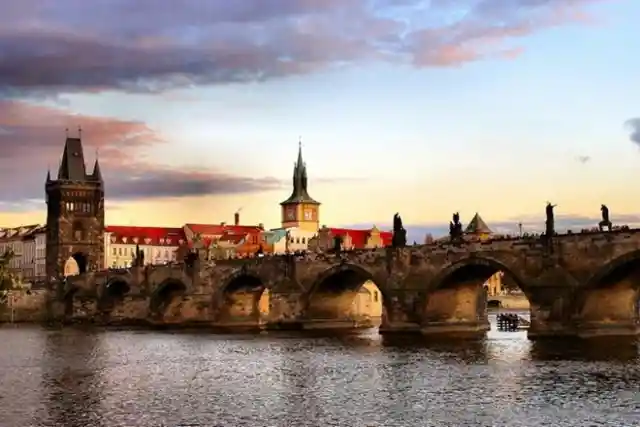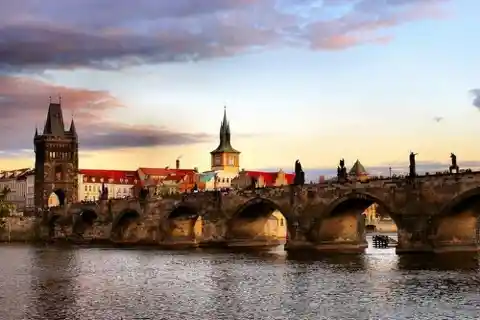It's better to build bridges, not walls as they say, and we couldn't agree more. There are countless bridges the world over and some are certainly better constructed than others as we'll see. These structures can be hand-made, machine constructed or naturally crafted.
The World Is A Narrow Bridge
They hover over all kinds of physical obstacles and elements while seemingly withstanding all weather conditions.
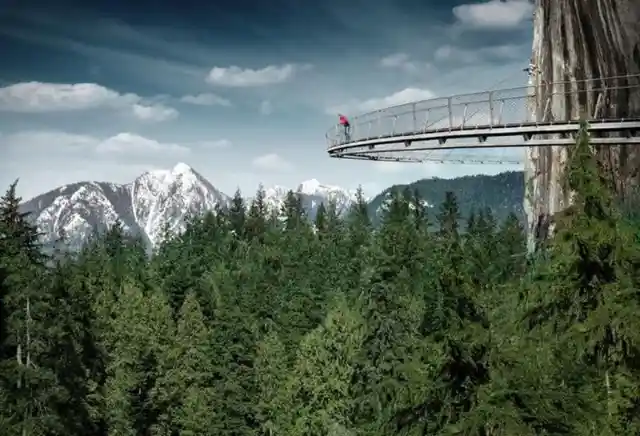
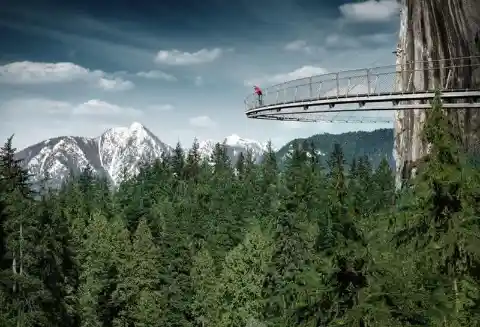
Join us as we look at the most spectacular bridges from around the world.
See the world's most spectacular bridges:
Brave-Man's Bridge – China


The glass suspension bridge aptly called The Brave Man's Bridge (高空玻璃桥), is 300 meters (984 feet) long, and 180 (590 feet) meters above the ground. It crosses two cliffs at a total of 540 meters (1172 feet) above sea level. It is the first high altitude glass-bottomed bridge ever built in China, originally made of wood and converted to glass in 2014.
Located at the Shiniuzhai National Geological Park in Hunan, in Pingjiang County, Chine, the origin of the name stems from a word of mouth rumor that anyone who crosses the fearsome bridge is a truly brave man.
Ai Petri Bridge – Ukraine
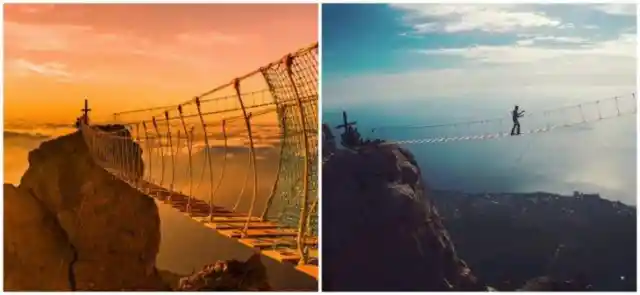
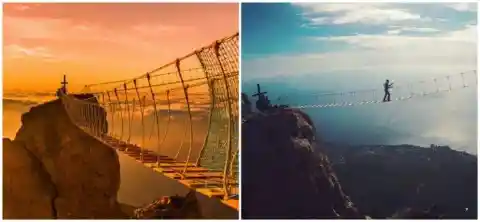
Ai-Petri (meaning Saint Peter) lies at the peak of the Crimean Mountains in Ukraine. It is one of the windiest places in Crimea with winds blowing for 125 days a year, reaching speeds of 110 miles per hour (50 miles per second). The peak is located above the city of Alupka and the town of Koreiz.
The rickety wood-slate cable footbridge crosses over a canyon over 4,000 feet deep and connects two peaks. It is also one of the foggiest places in Ukraine, adding an air of mystery and danger.
Longest Sea Bridge, China
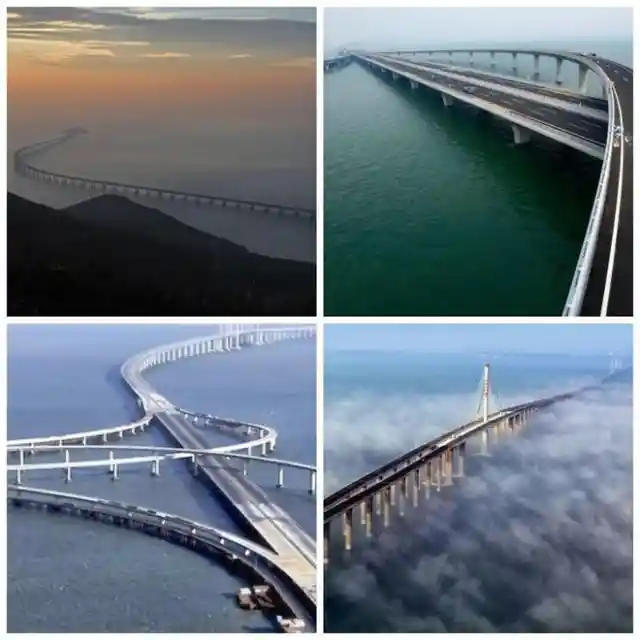
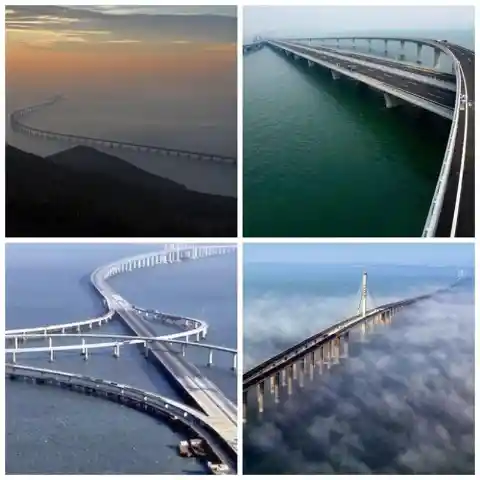
A 35 mile (55 km) long sea bridge has been officially opened in October 2018. The Hong Kong-Zhuhai is the world’s longest sea bridge and it connects Hong Kong and Macau to the Chinese mainland. There's a part of the roadway which is in a tunnel underwater. So you cross a bridge, drive into a tunnel and back out onto a bridge again. It sounds great, but why is it on this list?
Well, it's 35 miles long, without enough pitstops along the way if something happens, but the highlight is the technology used. The Chinese will be using cameras on the bridge to detect yawning. Even more, drivers on the bridge will be forced to wear heart monitors so they could be tracked along the bridge. That is SCARY.
Carrick-a-Rede Rope Bridge, Northern Ireland
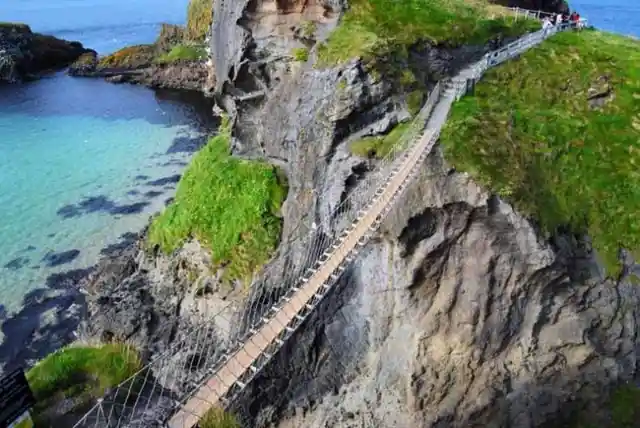
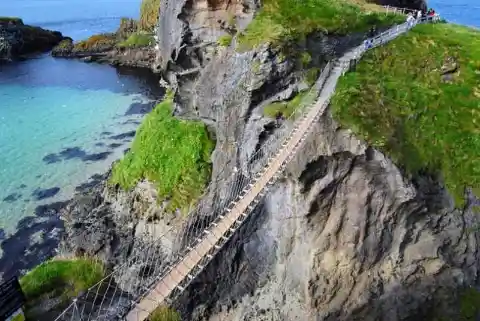
Locally pronounced "carrick-a-reedy", Carrick-a-Rede Rope Bridge is a 30 meter (98 foot) high, 20 meter (66 foot) long bridge near Ballintoy in County Antrim, Northern Ireland. The bridge links the mainland to the island of Carrickarede (Carraig a' Ráid, meaning "rock of the casting").
There have been several instances where visitors, unable to face the walk back across the bridge from the island, have had to be taken off the island by boat.
Keshwa Chaca Bridge – Peru


Queshuachaca or Keshwa Chaca is the last remaining Inca rope bridge. It spans the Apurimac River near Huinchiri, in Quehue District, Canas Province, Peru and measures 148 feet (45 meters) in length. It was constructed from ropes made of grass. Although a more modern bridge exists parallel, locals renew the bridge annually.
Baliem River Bridge – Western New Guinea
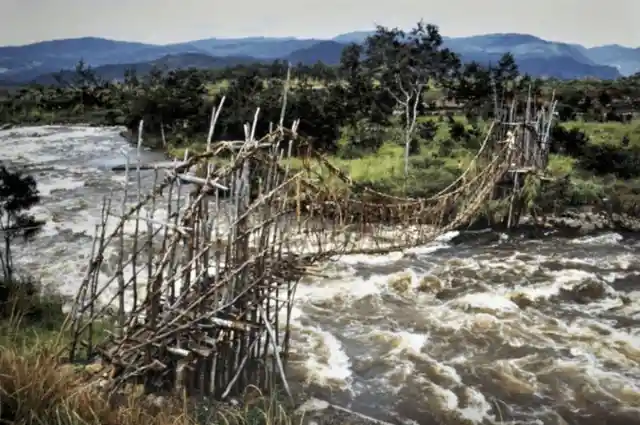
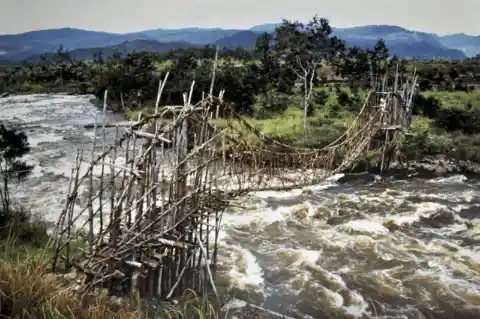
The Baliem Valley, also known as the Grand Valley, is located in the Central Highlands of Western New Guinea, contentiously part of Indonesia. Although the locals, the Dani people, who built the bridge appear to have used a bridge's outline, it would be a courageous soul who braves crossing these rapids on the structure. Bridge over troubled water, indeed.
Capilano Suspension Bridge – Canada
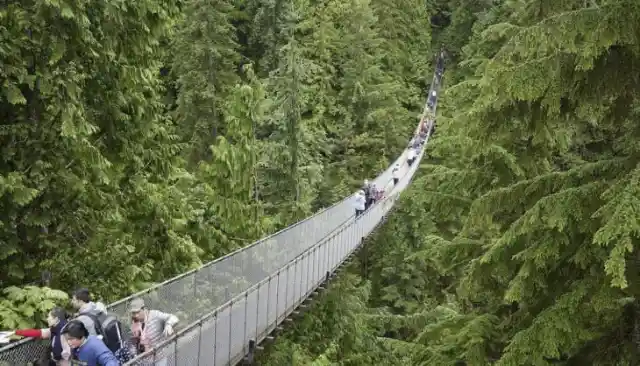
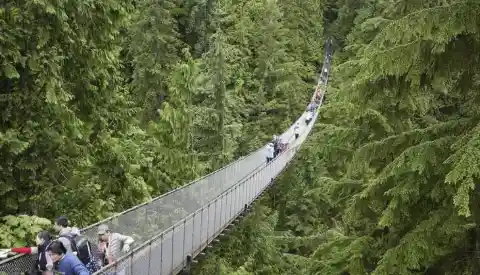
Sitting 460 feet (140 meters) above the Capilano River in the District of North Vancouver, British Columbia, Canada, the Capilano Suspension Bridge measures 230 feet (70 meters) in length. It was originally built in 1889 and made from hemp ropes with a deck of cedar planks but was replaced with a wire cable in 1903. It was completely rebuilt in 1956.
The bridge has been featured in several episodes of television series such as MacGyver, Sliders, The Crow: Stairway to Heaven, and Psych.
Iya Kazurabashi Bridge – Japan
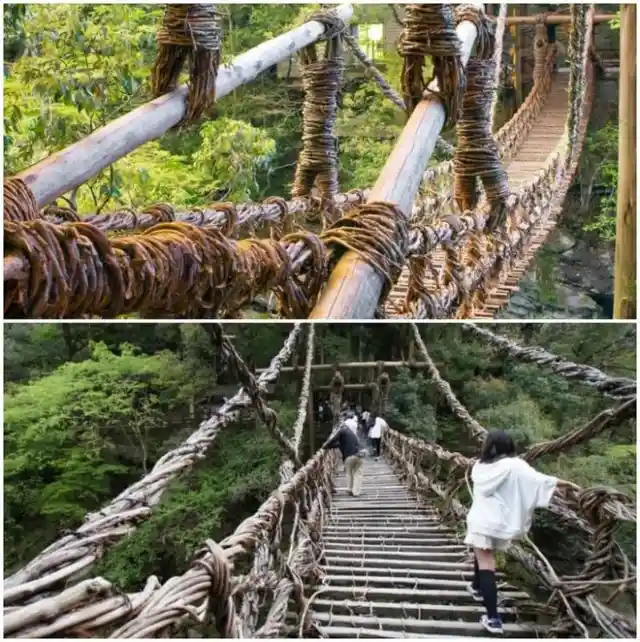
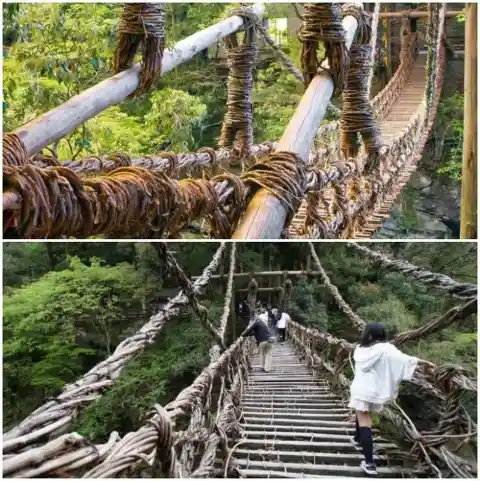
Several vine bridges span the Iya Valley in Tokushima Prefecture, Japan. Many of them being dated as far back as the 12th century when members of the Taira clan (aka Heike clan) supposedly entered the area after losing the Genpei War to the Minamoto clan.
The suspension bridges are made of mountain vines (kazurabashi) and slats which give an unsettling view of the waters 14 meters below. Thirteen bridges once spanned the valley, though only three remain today, the most notable being the Iya Kazurabashi (祖谷かずら橋) Bridge. It is rebuilt every three years and is anchored to tall cedar trees at each end.
Taman Negara Canopy Walkway – Malaysia
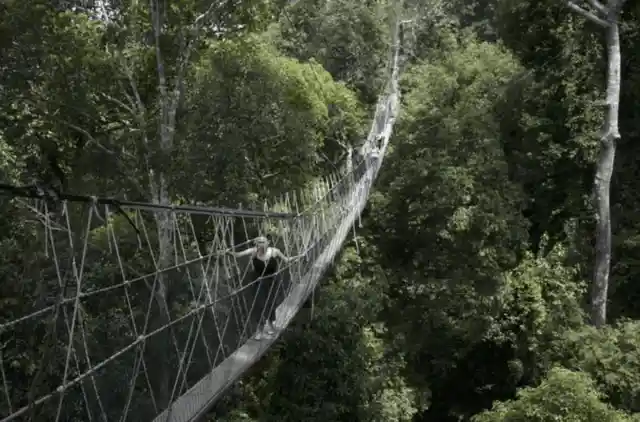
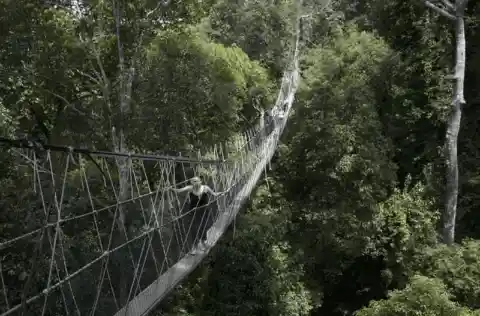
Considered the world's longest canopy walkway, the Taman Negara in Peninsular Malaysia, is built 530 meters long and 40 meters high. It is situated within an area of 4,343 kilometers in one of the world's oldest deciduous rainforests.
Captain William Moore Bridge – Alaska
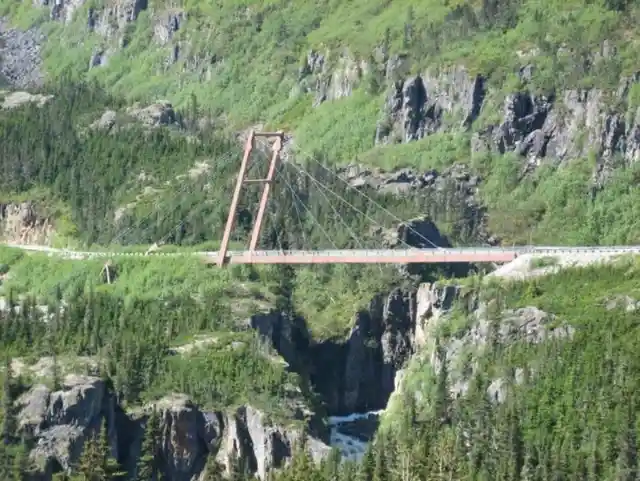
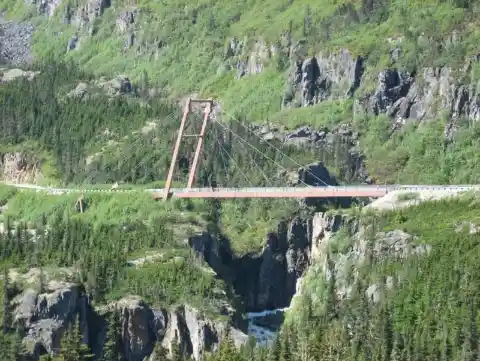
The Captain William Moore Bridge was built in 1976 and stands at 110-feet over the Klondike Highway, 17 miles from Skagway, Alaska. The bridge allows traffic to pass over the Moore Creek Gorge. Due to the gorge passing through a fault line, the bridge is only anchored at one end in order to prevent it from being torn apart by an earthquake.
Due to the deteriorating nature of the bridge, it is slated to be replaced by the end of the year, with the bridge being converted to a pedestrian walkway.
Marienbrücke – Germany
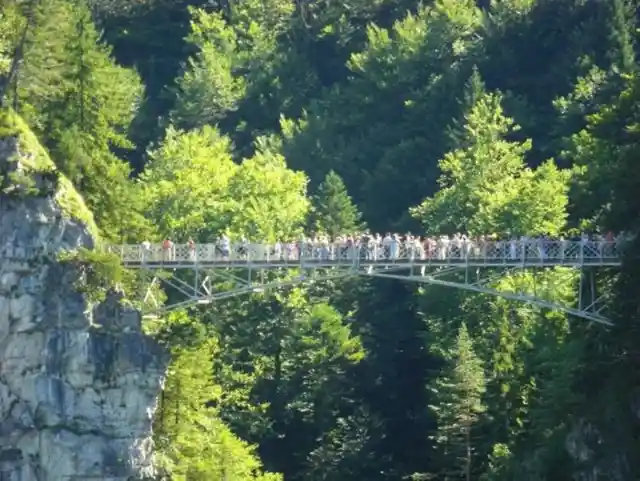
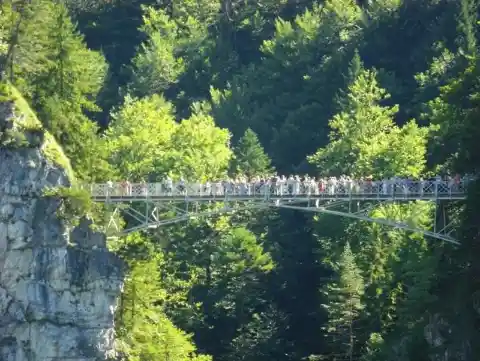
Marienbrücke (Marie's Bridge, or Pöllatbrücke) was built for Queen Marie of Prussia by King Maximilian II (the husband of Queen Marie) who built it for her. It was named by Ludwig II of Bavaria (their son) after his mother. It was constructed in 1845 over the "Pöllatschlucht". The bridge is popular today as it offers excellent views of Neuschwanstein castle and its surroundings.
Mackinac Bridge – Michigan
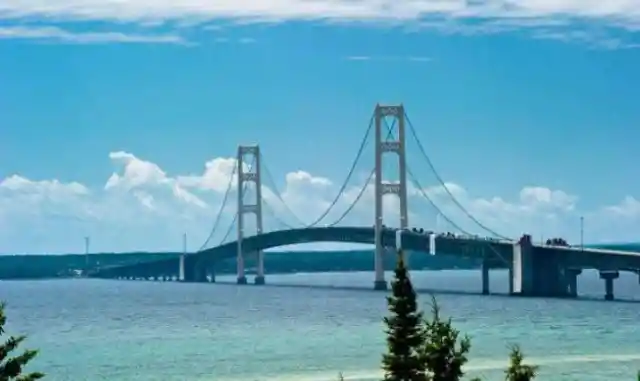
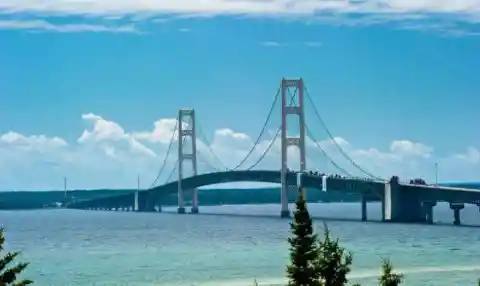
The Mackinac Bridge (known as the "Big Mac" and "Mighty Mac") is a suspension bridge which spans the Straits of Mackinac to connect the Upper and Lower Peninsulas of the U.S. state of Michigan. The 26,372 foot-long (5 miles or 8,038 meters) bridge was built in 1957 and has the world's 20th longest main span and the largest between anchorages in the Western Hemisphere.
Musou Tsuribashi Bridge – Japan
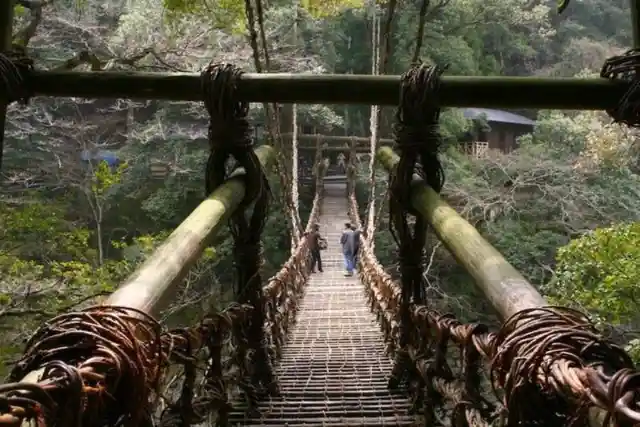
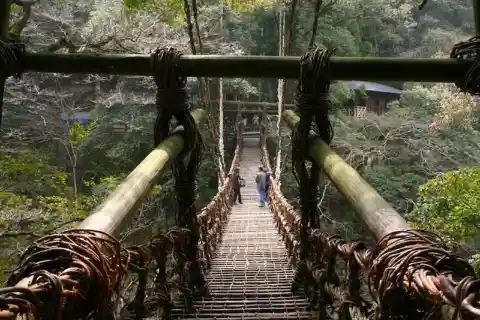
Known as Japan's scariest suspension bridge, it was built sometime in the 1950s and not exactly maintained. it is located in the Southern Japanese Alps known as Mosou Tsuribashi. The bridge is mainly held up by wire and thin wooden boards. To reach the bridge individuals must climb the side of the mountain by holding onto metal chains due to its steepness.
Chesapeake Bay Bridge – Maryland
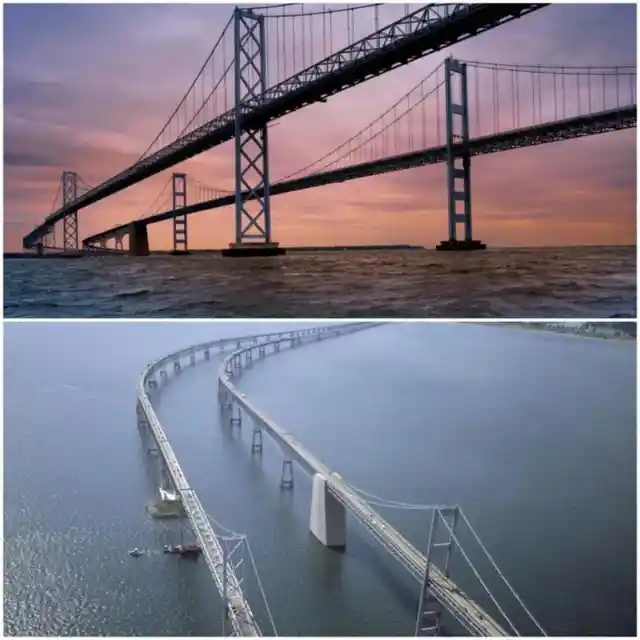
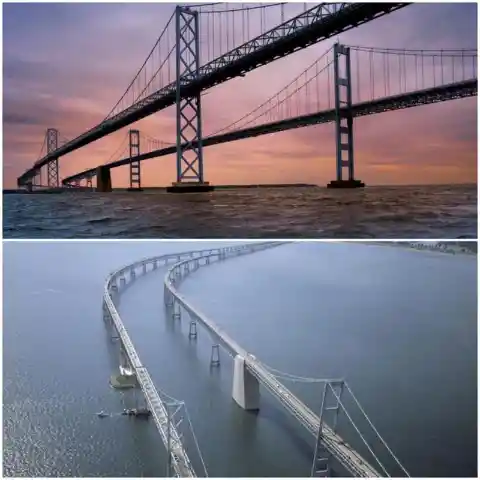
Known locally as the "Bay Bridge", the Chesapeake Bay Bridge, officially named the "Gov. William Preston Lane Jr. Memorial Bridge is a major dual-span bridge in Maryland. The bridge connects the state's urban West Shore with it's rural Eastern Shore and measures 4.3 miles (6.9 km) in length and 186 feet (56.7 meters) high. Built in 1952, its parallel span was constructed in 1973.
Kawarau Gorge Suspension Bridge – New Zealand
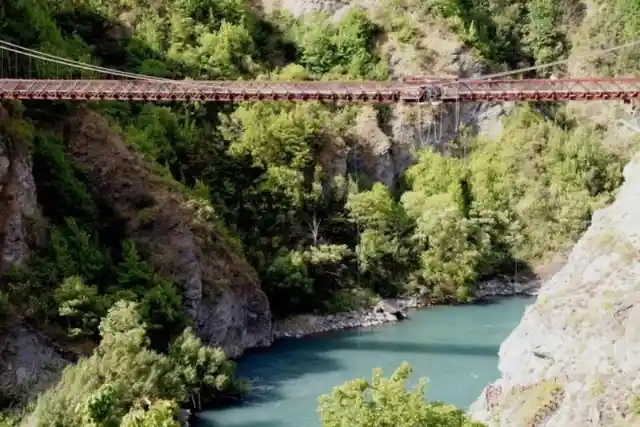
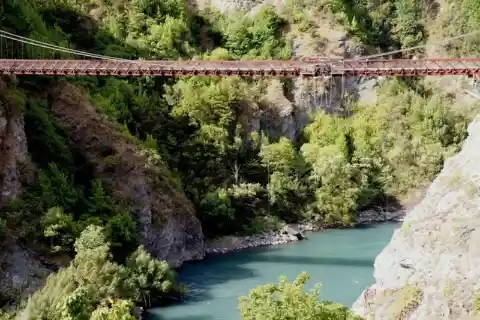
The Kawarau Gorge Suspension Bridge runs over the Kawarau River in the Otago region of the South Island of New Zealand. It is also the world's first commercial bungy jumping site. It measures 43 meters (141 feet) in height from the river bed and completed in 1880. The river featured as a setting for the Argonath in the motion picture, The Lord of the Rings: The Fellowship of the Ring.
Moses Bridge, Netherlands
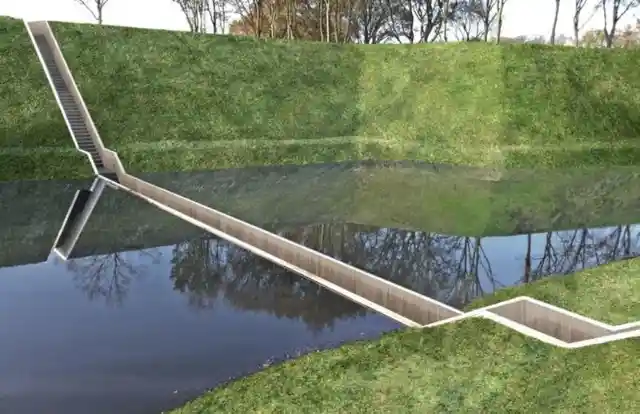

Once an active defense-line in the 17 century, the Fort de Roovere fell into disrepair in the 19th century but has since been restored. Most notable is the "invisible" bridge, Moses Bridge, at Halsteren, Netherlands. The discreet entry to the fort makes it possible to enjoy the area without ruining the moat’s presence, thanks to adjustable dams at both sides of the moat and a pump.
Henderson Waves – Singapore
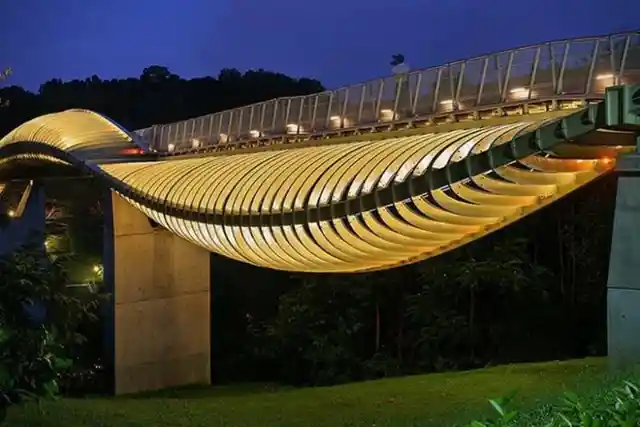

Henderson Waves (亨德森波浪桥), built in 2008 is 274-meter (899 feet) long pedestrian bridge, hovering 70 meters (230 feet) above Henderson Road. It is Singapore's highest pedestrian bridge and offers views of the southern part o Singapore and the Southern Islands. The bridge has a waveform and is lit with LED lamps from 7 pm to 2 am daily.
Mur Island Bridge – Austria
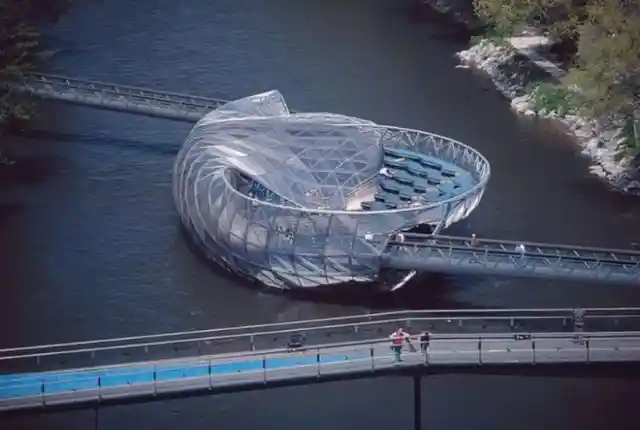
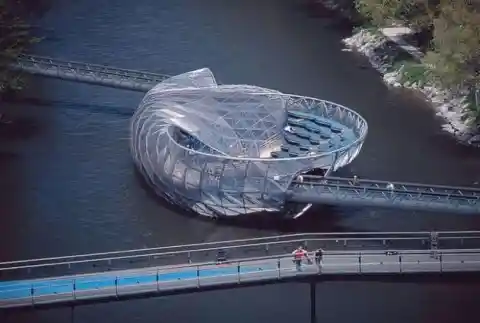
The Murinsel (Mur Island) Bridge in Graz, Austria is an artificially created floating "island" which lies in the middle of the Mur river. It was created in 2003 when the city became the European Captial of Culture for the year.
The artist who designed it describes it as "A bowl that morphs into a dome that morphs into a bowl…". It measures 47 meters (154 feet) in length and connects both banks of the river Mur. with a footbridge on either side.
Pont de Singe – England
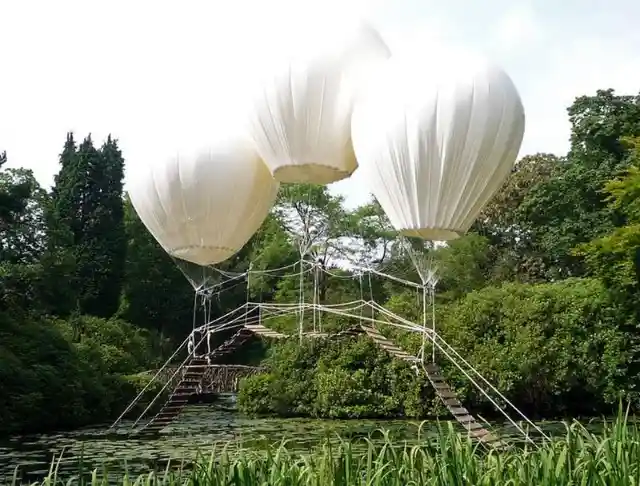
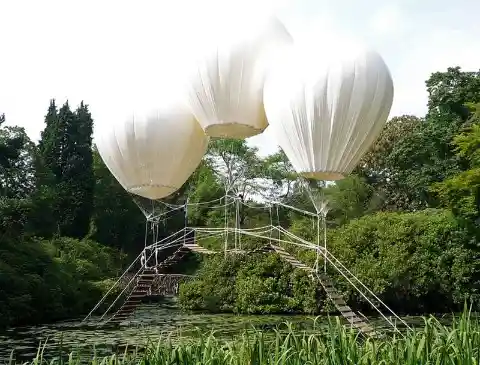
In order to float this bridge over a lake in Tatton Park, a historic estate in north-west England, French artist Olivier Grossetête used three large helium balloons. Pont de Singe, which means "monkey bridge", is made up on a long rope bridge made of cedar wood with the ends trailing in the water. It was created for the park's biennial themed around flight.
Before you get too excited, note that the bridge is not functional but strictly sculptural. However, theoretically, it would be strong enough to hold the weight of a person, according to Grossetête.
Rakotzbrücke (Devil’s Bridge) – Germany
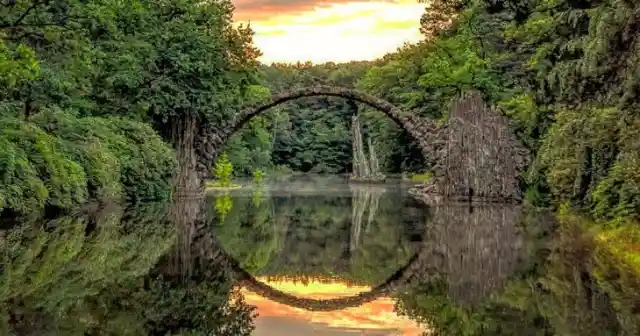
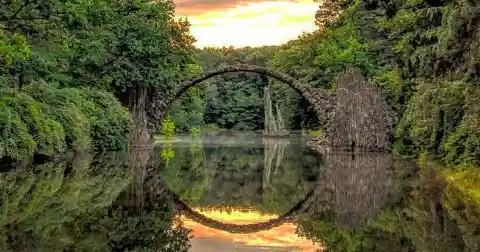
Located in Azalea and Rhododendron Park Kromlau, a 200-acre (21 ha) landscaped park in Gablenz, Germany less than 6 kilometers from the Polish border is this the Rakotzbrücke (also called the Devil's Bridge). It was created in the mid-19th century to create a reflecting circle with the waters beneath.
Several ancient bridges are termed Devil's Bridge. Most of these are stone or masonry arch bridges and usually represent a significant technological achievement for its time. Each of the Devil's Bridges has a corresponding Devil-related myth or folktale. This one, however, was formed from basalt columns shipped from distant quarries.
Confederation Bridge – Canada
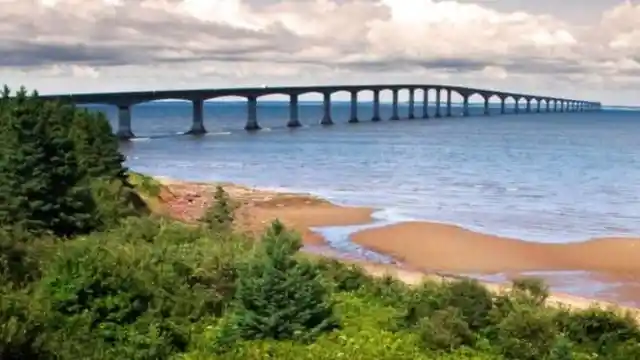

Spanning the Abegweit Passage of Northumberland Strait and linking Prince Edward Island with mainland New Brunswick, Canada, is the Confederation Bridge. Previously the bridge was known as the "Fixed Link". The 12.9 kilometer (8 mile) bridge was opened in 1997 and cost C$1.3 billion to complete. It is considered one of Canada's top engineering achievement of the 20th century.
Ponte Vasco da Gama – Lisbon
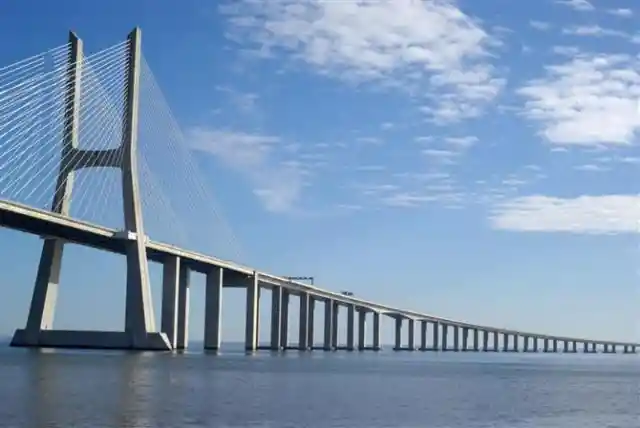
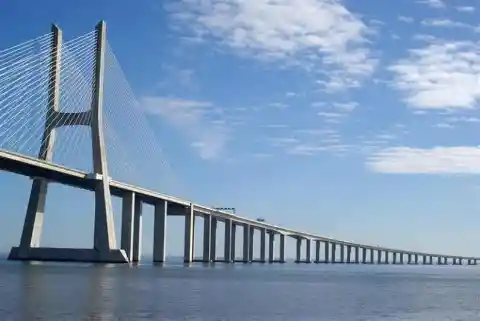
The second longest bridge in all of Europe, the Ponte Vasco da Gama Bridge spans the Tagus River in Parque das Nações in Lisbon, Portugal. Measuring 12.3 kilometers (7.6 miles) the cable-stayed bridge is flanked by viaducts and range views and It is built to hold up to an earthquake 4.5 times than the 1755 Lisbon earthquake, estimated at 8.5-9.0 on the moment magnitude scale.
Pont du Gard – France
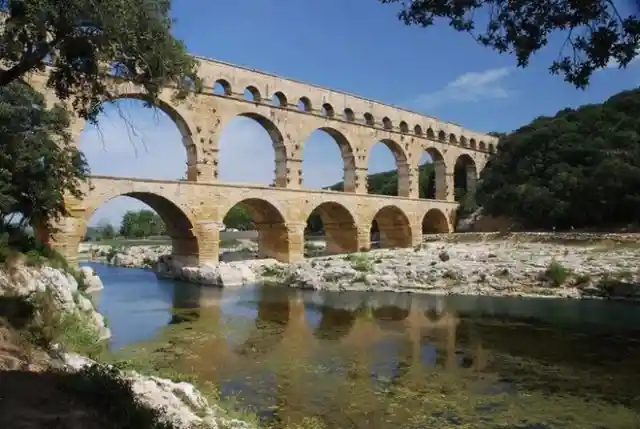
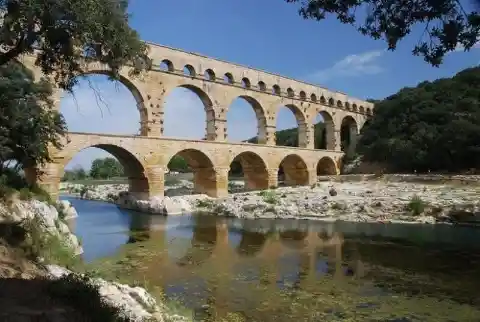
Recognized as a UNESCO World Heritage Site, the Pont du Gard built between 40-60 ACE, crosses the Gardon River near the town of Vers-Pont-du-Gard in southern France. The highest of all elevated Roman aqueducts at 48.8 meters (160 feet) and one of the best preserved, it measures 275 meters (902 feet) in length.
The aqueduct once carried an estimated 40,000 cubic meters of water a day to the fountains, baths, and homes of the citizens of Nîmes. Today the bridge is accessible only to pedestrians and cyclists.
Kintai Bridge – Japan
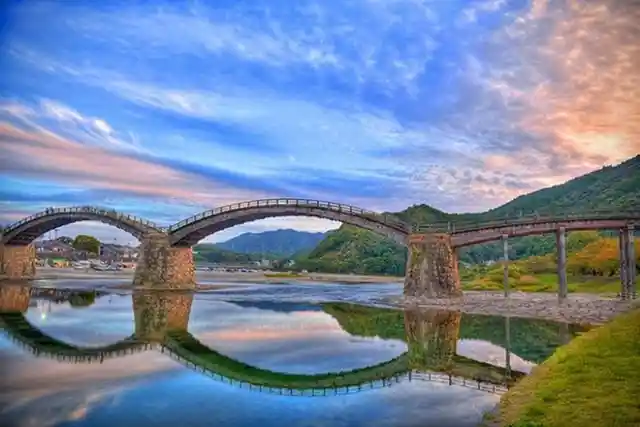
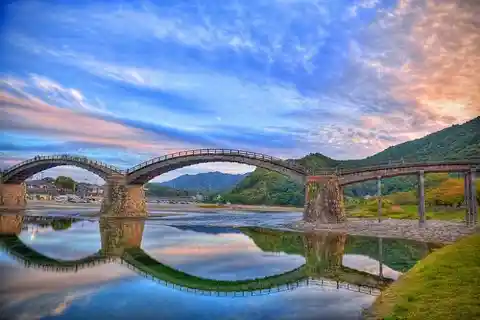
Built in 1673, the Kintai Bride (錦帯橋 Kintai-kyō) spans the Nishiki River in a series of five wooden arches and is located at the foot of Mount Yokoyama. The bridge was designed so that the wooden pathway "floats" on top of its frame using mortise and tenon joints thus allowing passing flood waters to carry off the structure without affecting the main structure.
Slater Bridge – England
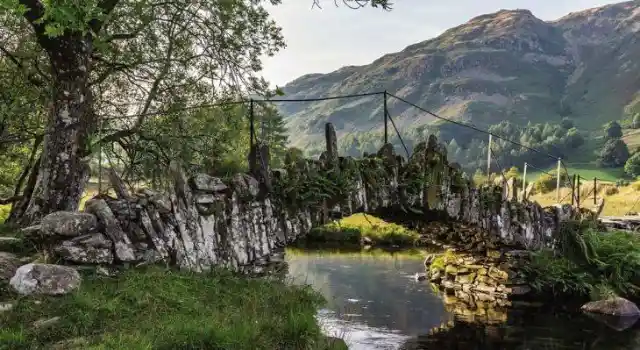
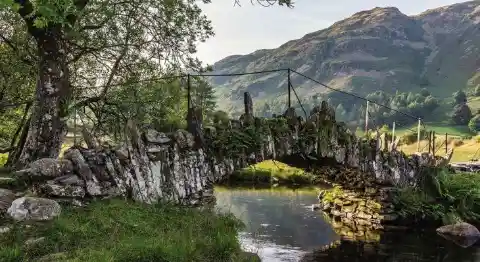
Located in the Lake District of England, Slater Bridge lies on the route between Little Langdale and Tiberthwaite. The bridge crosses the River Brathay and is a 16th-century, slate-built, former packhorse bridge.
Aqueduct de los Milagros – Spain
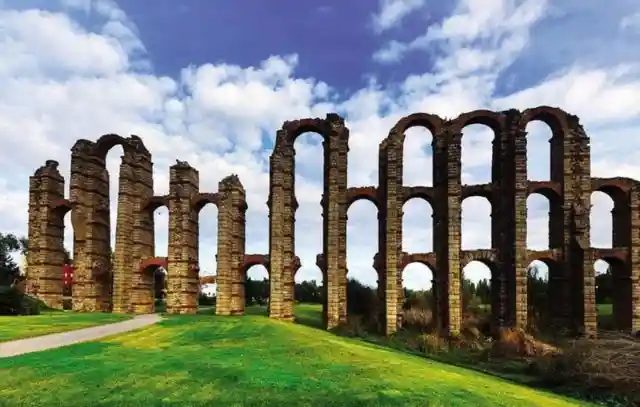
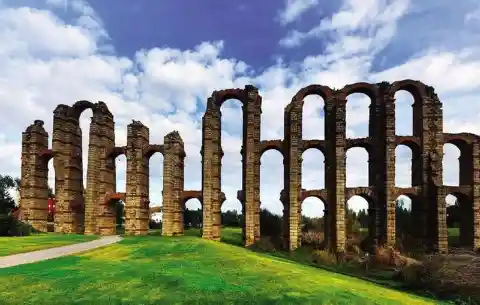
The Acueducto de los Milagros (Miraculous Aqueduct) located in Mérida, Spain holds the ruins to a Roman aqueduct which was used to supply water to the Roman colony of Emerita Augusta. Only a remnant of the aqueduct stands today, consisting of 38 arched pillars standing 25 meters (82 feet) high along a course of some 830 meters (2,720 feet).
Historians believe it was constructed in the 1st century ACE, with a second phase (possibly renovations) around 300 ACE.
Carioca Aqueduct – Rio de Janeiro
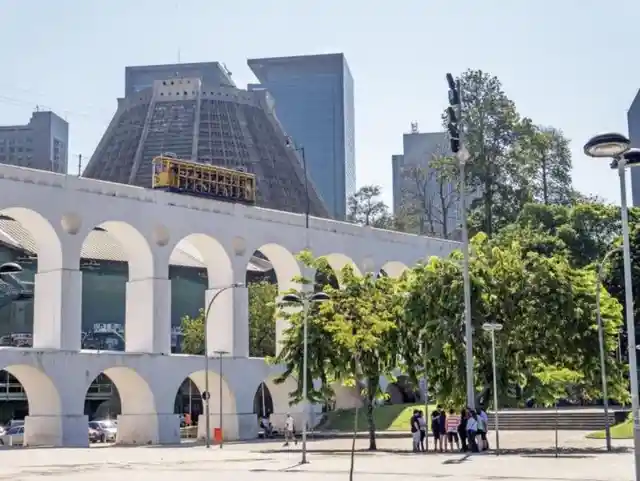
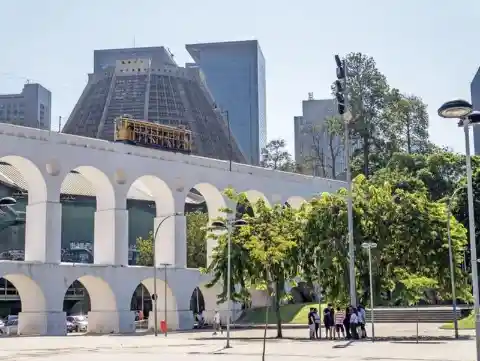
Built in the middle of the 18th century to bring fresh water from the Carioca River to the city of Rio de Janeiro in Brazil, the carioca aqueduct is frequently called Arcos da Lapa (Lapa Arches) by Brazilians. Since the 19th century, it serves as a bridge for a tram which connects city center with the Santa Teresa neighborhood. It measures 270 meters in length and 17.6 meters in height.
Bhumibol Bridges – Bangkok
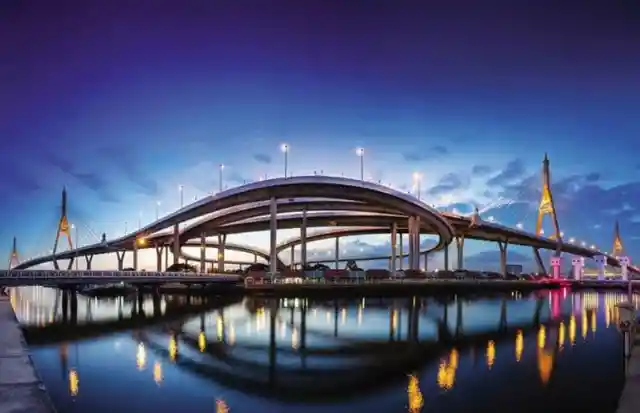
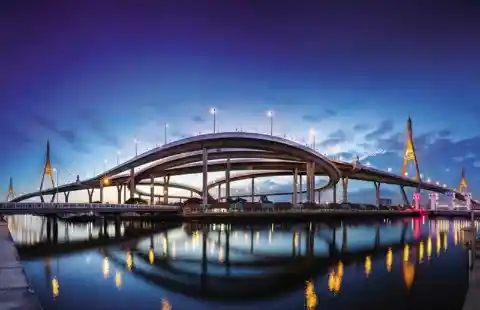
Also known as the Industrial Ring Road Bridge (สะพานวงแหวนอุตสาหกรรม), the Bhumibol Bridge (สะพานภูมิพล) is part of a 13-kilometer long road connecting southern Bangkok with Samut Prakan Province.
It crosses the Chao Phraya River twice, with two striking cable-stayed spans 702 meters and 582 meters in length supported by two diamond-shaped pylons 173 meters and 164 meters high.
Titlis Cliff Walk, Switzerland
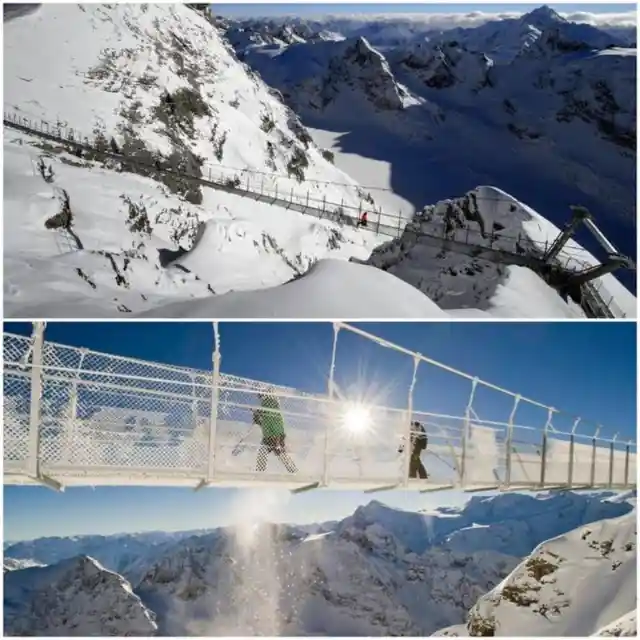
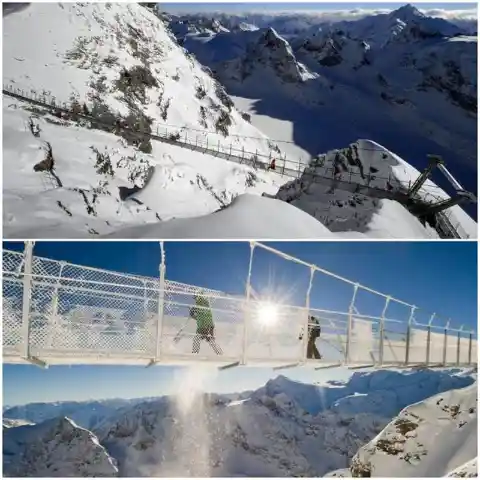
Measuring an awe-inspiring 3,238 meters (10,623 feet) above sea level, Mount Titlis located on the border between the cantons of Obwalden and Bern in Switzerland is home to the Titlis Cliff Walk which is the highest elevation suspension bridge in Europe. It offers breathtaking views across the Alps and was first opened in December 2012.
On a clear day, it is possible to see the glacier 1,500 feet (460 m) below the bridge along with the Uri Alps and parts of Italy. The ski resort spokesman claims that the bridge is "100 percent safe" and explains that it is "really impossible to fall from the bridge". Who would ever wish to prove them wrong?
Trans-Baikal Region Bridge, Russia
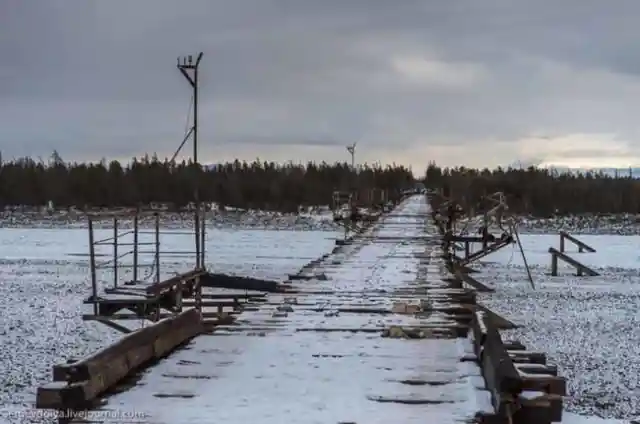
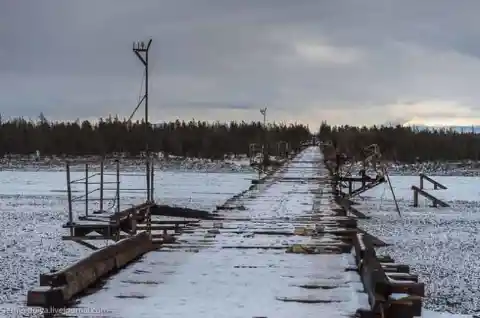
The old railway bridge over the Vitim River, a major tributary of the Lena River, has had very few people cross it. The bridge has no guard rails, or safety features. Drivers must navigate a tiny six-foot-wide path to save them from toppling into the frozen water below. It has not seen repairs in three decades and measures 1,870 feet in length.
Buxian Bridge, Huang Shang China
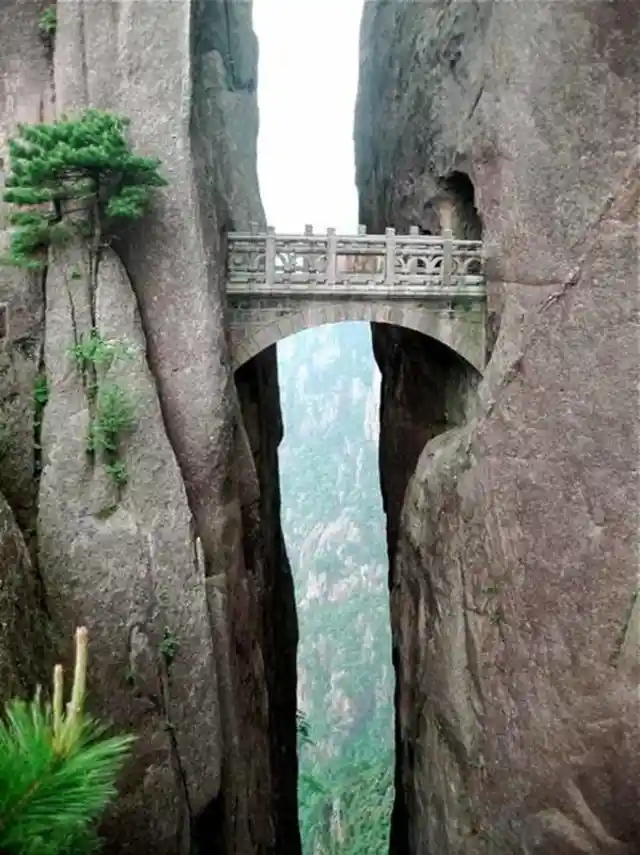
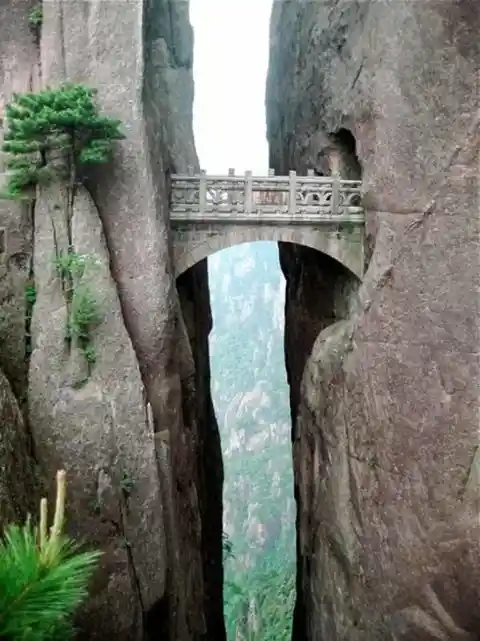
The short pedestrian bridge is known as the "Fairy Walking Bridge" due to its magical appearance. Buxian Bridge spans the chasm between two giant rock faces and was surprisingly only built in 1987. It was deliberately built to give a much earlier look and feel of some ancient Chinese relic.
Monteverde Cloud Forest, Costa Rica
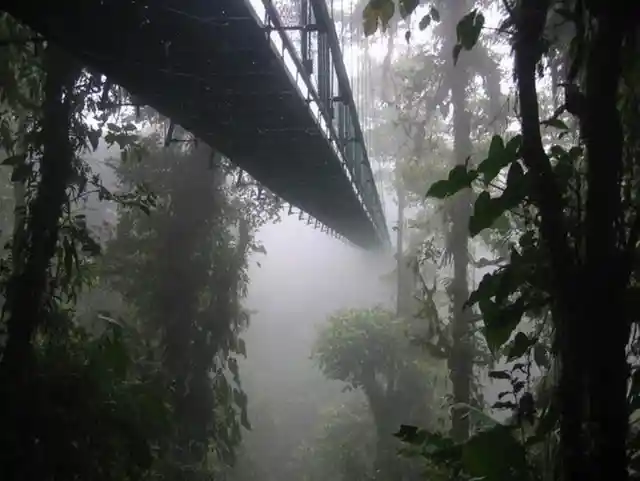
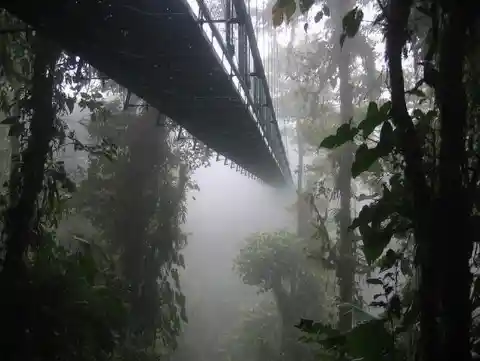
Monteverde Cloud Forest in Costa Rica is home to the Hanging Bridge. It is made of wood and string and runs through the rainforest. The fragile bridge, as well as its missing rungs, makes for one scary walk. The reserve is home to over 2,500 plant species, 100 species of mammals, 400 bird species, 120 reptilian and amphibian species, and thousands of insects.
Storseisundet Bridge, Norway
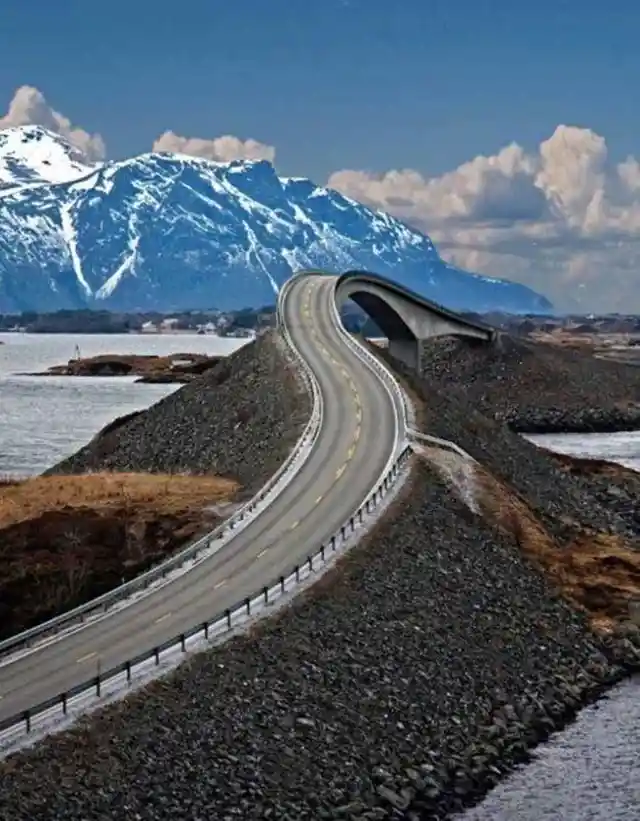
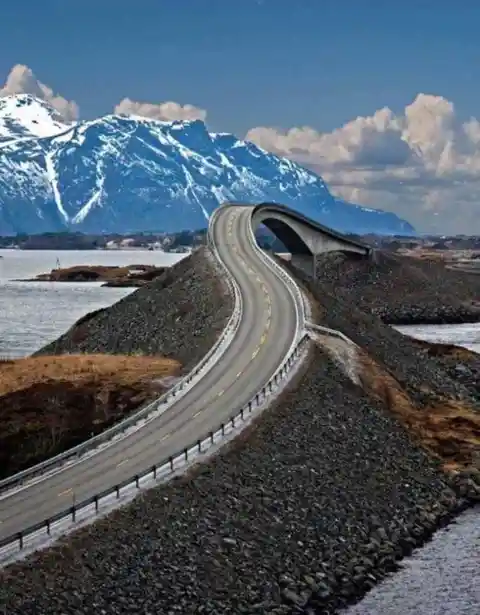
The Storseisundet Bridge lies on the border between Eide Municipality and Averøy Municipality and passes through an archipelago as it links mainland Norway with the island of Averoy. The bridge is described as "The road to nowhere" and is a cantilever bridge measuring 260 meters (850 feet) long and with a maximum clearance to the sea of 23 meters (75 feet).
Sidu River Bridge, China
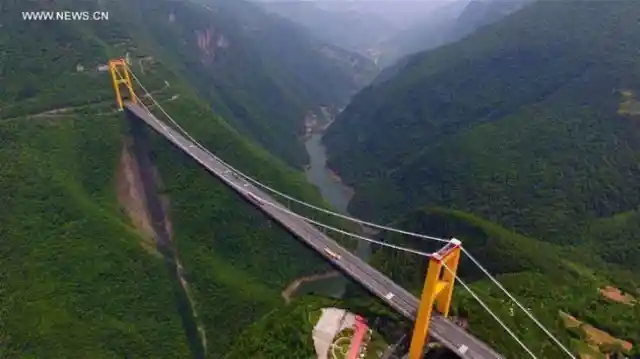
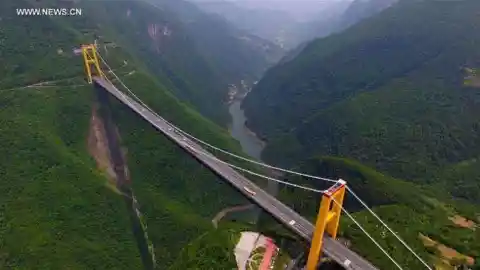
The 1,222 meter (4,009 foot) long Sidue River Bridge (Siduhe Bridge, 四渡河特大桥) in Badong County of the Hubei Province in China crosses the Sidu River. It was opened in 2009 and spans a 500 meter (1,600 foot) deep valley. It is the second highest bridge in the world and was the highest for six years before being overtaken by the Duge Bridge (also in China) in 2016.
Hussaini Hanging Bridge, Pakistan
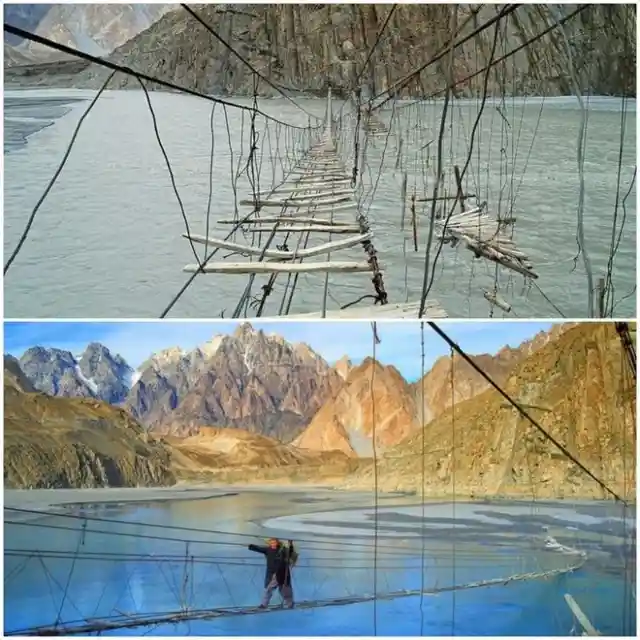
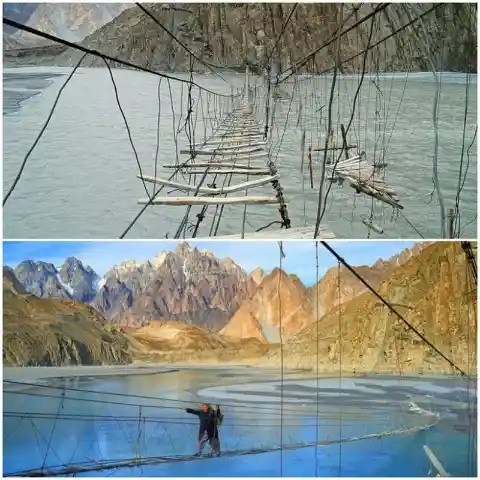
Known as the most dangerous bridge in the world, the Hussaini Hanging Bridge which crosses the Borit Lake in the Upper Hunza region of Pakistan. This rope bridge is both long and poorly maintained, with many planks missing. Every cold wind blowing from the mountains of the Karakoram causes the bridge to shake. The older bridge's remains can be seen next to the "new" one.
Seven Mile Bridge, Florida
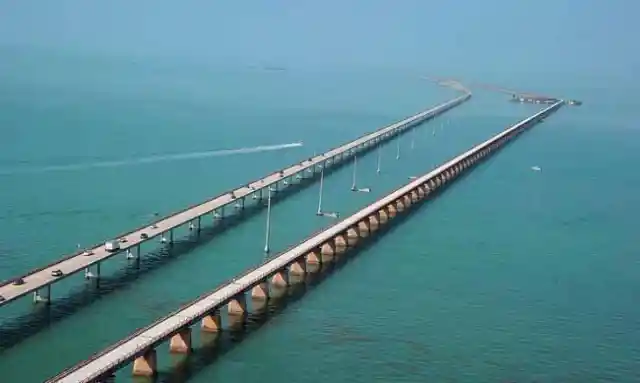
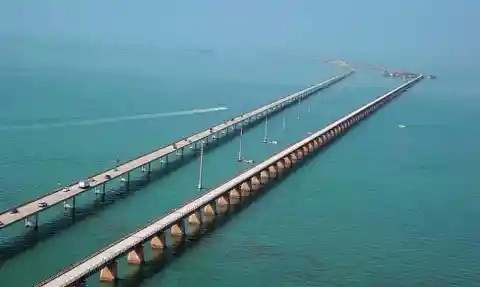
In the Monroe County of Florida, you can drive over the famous Seven Mile Bridge which passes through the Florida Keys. It was at one time one of the longest bridges in existence. Technically, there are two bridges today: the modern is one open to vehicles, while the older one is only accessible to pedestrians and cyclists.
The bridge has featured in films such as Licence to Kill, True Lies, 2 Fast 2 Furious, as well as the television series Burn Notice.
Longjiang Bridge – China
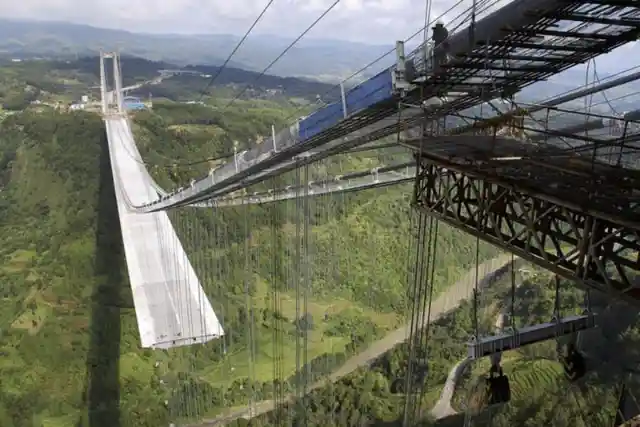
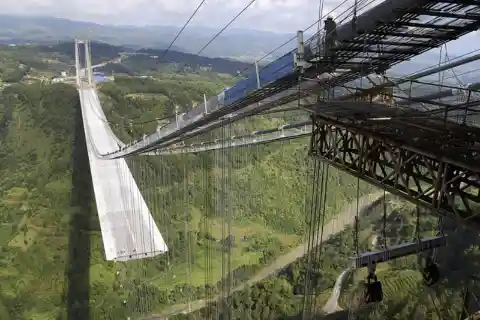
The Longjiang Bridge (龙江特大桥) or the Long River Bridge is a suspension bridge near Baoshan, Yunnan, China. It is one of the longest bridges ever constructed, measuring 3,924 feet (1,196 meters) in length. It is also one of the highest in the world, sitting 920 feet (280 meters) above the river below. before the bridge was built in 2016, the route was 13.5 km longer for motorists.
Deception Pass Bridge, Washington State
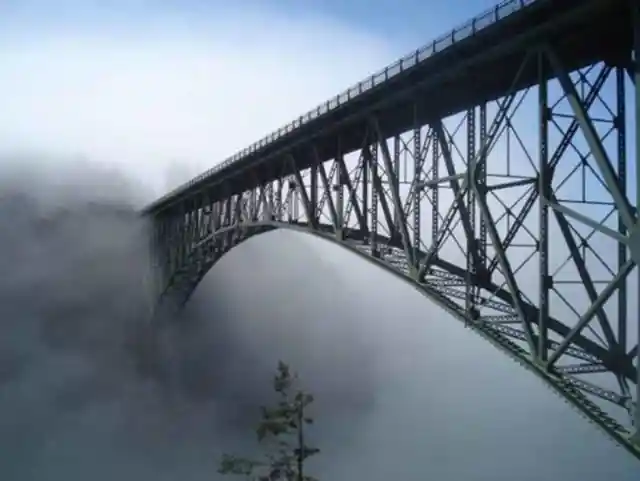
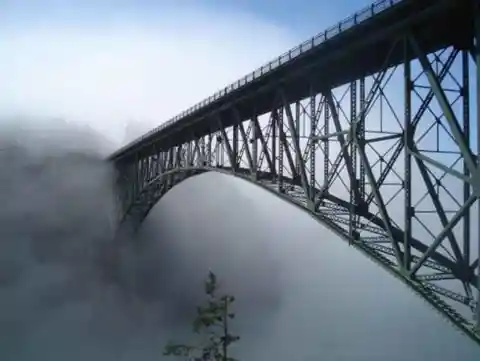
The Deception Pass Bridge connects Whidbey Island to Fidalgo Island in the state of Washington. The bridge is one of the scenic wonders of the Pacific Northwest, with Pass Island lying between the two sections of the bridge. It sits 180 feet (55 meters) above the water, depending on the tide. Prior to the construction of the bridge, people could only venture to and from the islands via ferry.
Lake Pontchartrain Causeway, Louisiana
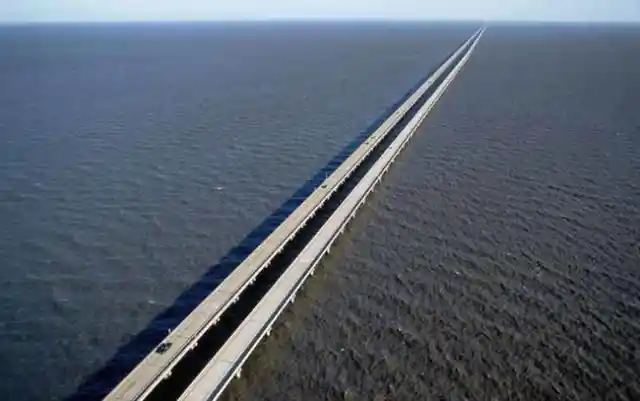
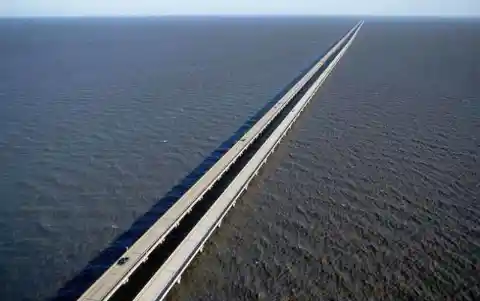
The Lake Pontchartrain Causeway, sometimes simply called the Causeway, is a fixed link of two parallel bridges crossing the aforementioned lake in Louisiana. The longer of the two bridges is 23.83 miles (38.35 km) long. For 8 of its 24 miles, you can't see land in any direction.
It has been listed as the world's longest bridge over water (continuous) by Guinness World Records since 1969 and takes a half-hour drive to cross.
Kakum Canopy Walkway, Ghana
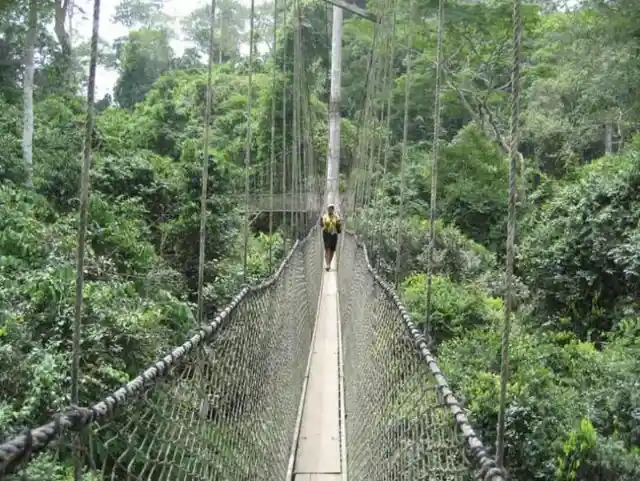
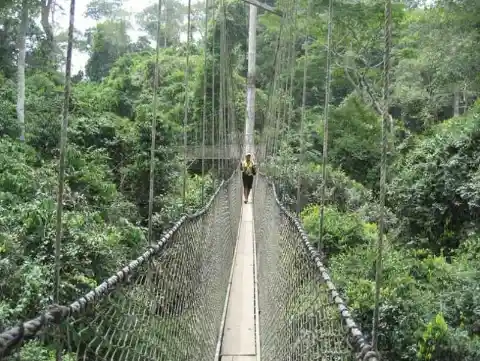
The Kakum Canopy Walkway located in the Central Region of Ghana claims to be the only canopy walkway in all of Africa. It extends for more than 1,150 feet (350 meters) and is suspended 130 feet (40 meters) in the air. At its highest, it is over 160 feet (50 meters) above the forest. It is built with wire rope, aluminium ladders, wooden planks, and includes safety netting.
Monkey Bridges, Vietnam
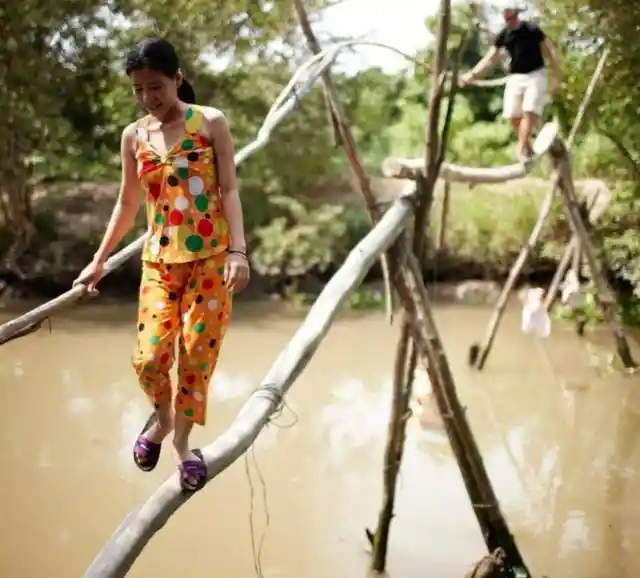
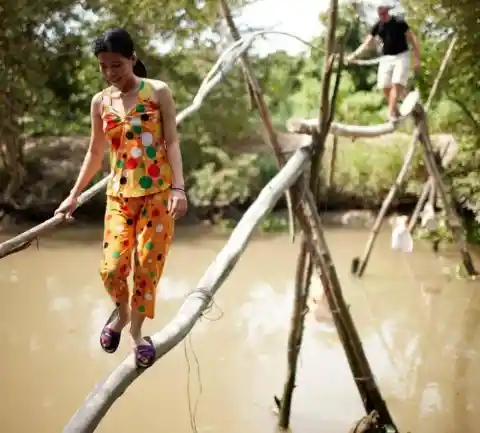
In Vietnam, a "monkey bridge" (Cầu khỉ) is a handmade bamboo or wooden passway across a stream or gully. It is a unique Vietnamese traditional symbol and is sometimes called a coconut bridge (if made of a coconut tree) or bamboo bridge (if made of bamboo). Various types of monkey bridges exist across the Mekong Delta due to the systems of streams.
The bridges, at times having handrails, are difficult to cross for those accustomed to them. Locals have been known to carry 20-50kg on their shoulder while crossing the bridge.
Langkawi Sky Bridge, Malaysia
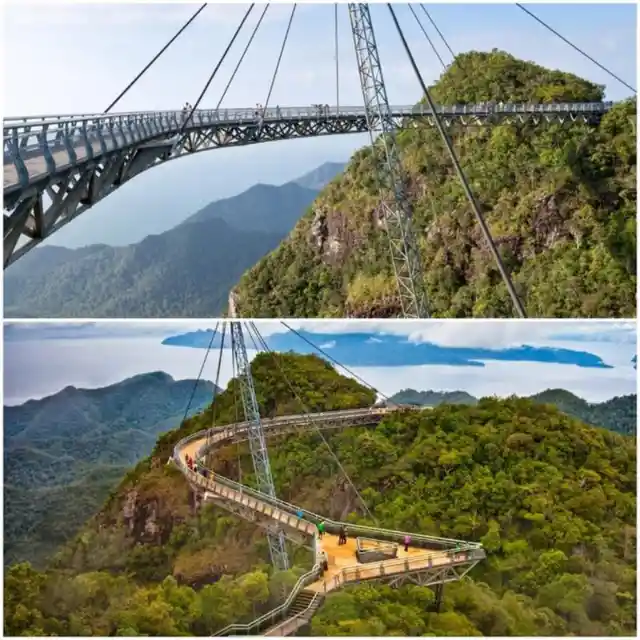
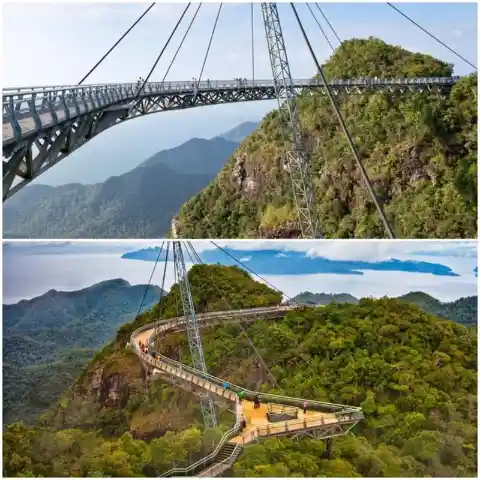
The 410 foot (125 meters) curved pedestrian cable-stayed bridge in Malaysia is located 2,170 ft (660 meters) above sea level on Pulau Langkawi, the main island of the Langkawi archipelago in Kedah. The bridge is 1.8 meters wide with two steel railings as well as steel wire and mesh on either side. It has a maximum capacity of 200 people.
Royal Gorge Bridge, Colorado
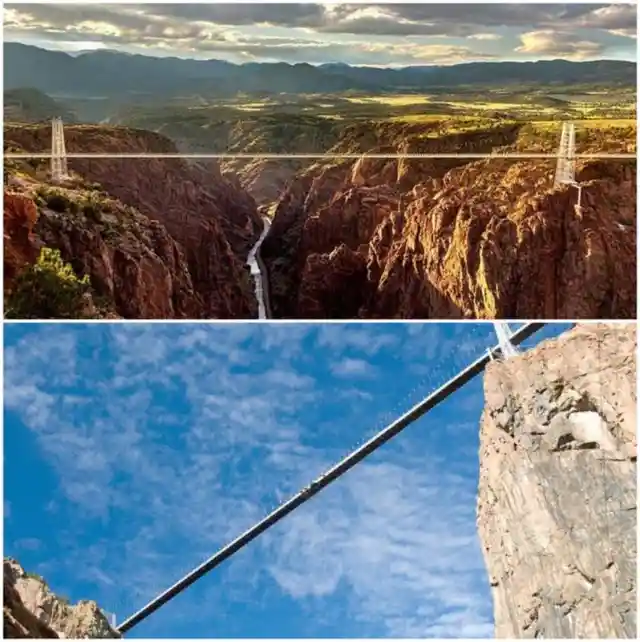
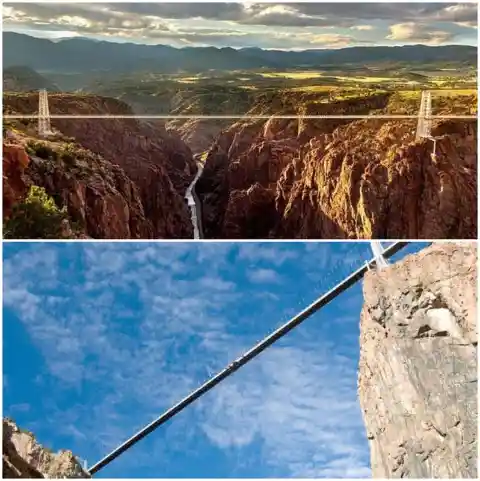
Colorado's Royal Gorge Bridge is a popular tourist attraction near Cañon City. The bridge crosses the gorge at 955 feet (291 meters) above the Arkansas River. From 1929 to 2001 it held the record for being the highest bridge in the world, and still remains the highest one in the United States. Interestingly, cable anchors, suspensions rods and paint were only added in the 1980s.
Ojuela Bridge, Mexico
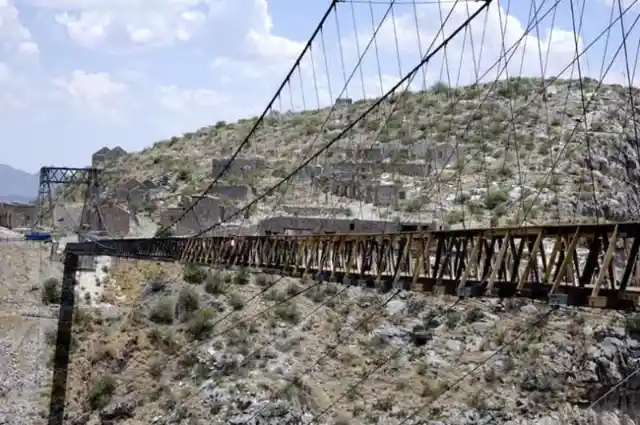
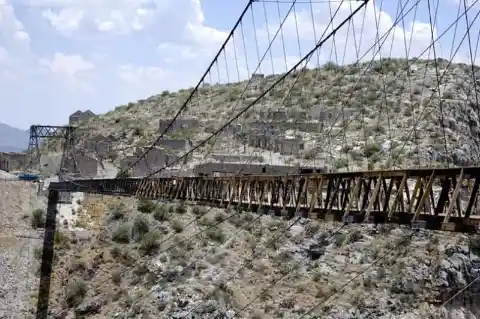
The Ojuela Bridge (Puente de Ojuela) or the Mapimi Bridge is a suspension bridge located in Mapimi, in the state of Durango, Mexico. It is built at the site of the Ojuel Goldmine and was completed in 1898, and restored in 1991 as a tourist attraction. Currently, the bridge is only used by pedestrians.
Quepos Bridge, Costa Rica
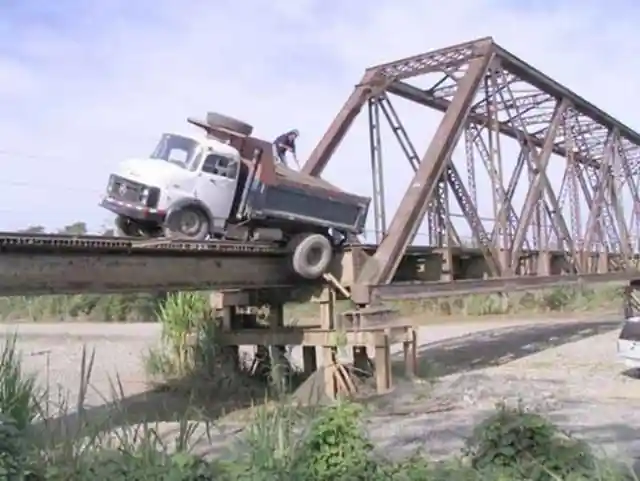
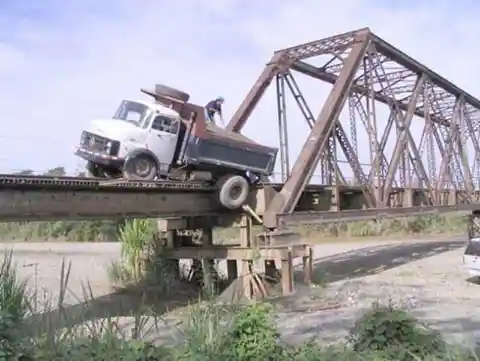
Known as the"Bridge of Death" or the "Oh My God Bridge", the narrow bridge is located on the central Pacific coast road from Jaco to Quepos in Costa Rica. Vehicles can only travel one way despite the bridge the loose slats of the roadway which clank loudly under their weight. It was originally built for a train which transported bananas to the port of Quepos.
Sunshine Skyway Bridge, Florida
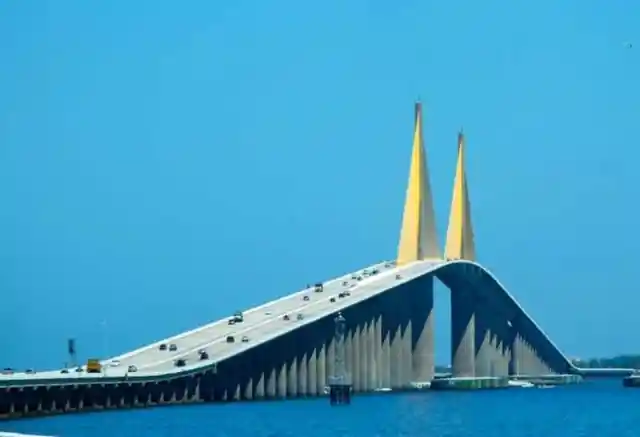
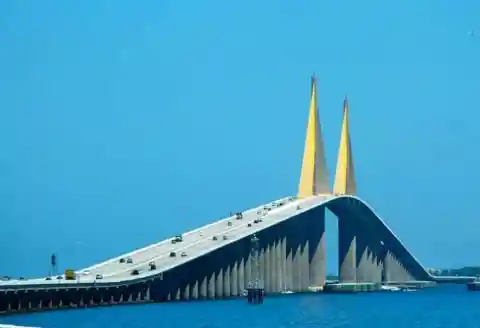
Measuring at 21,877 feet ((4.1434 miles or 6.668 km) in length, the Bib Graham Sunshine Skyway Bridge, commonly just called the Sunshine Skyway Bridge or the Skyway, spans Tampa Bay, Florida with cable-stayed main span. It was opened in 197 and replaced an older bridge which was destroyed in collision seven years earlier. It is considered the "flag bridge" of Florida.
As of 2009, at least 207 people have committed suicide by jumping from the center of the bridge into the waters of Tampa Bay since its opening in 1987, with another 34 trying but surviving. It is also a popular spot for filming automobile commercials due to its height above the emerald-green waters, length of continuous travel, warm-weather feel, and modern architectural design.
Eshima Ohashi Bridge, Japan
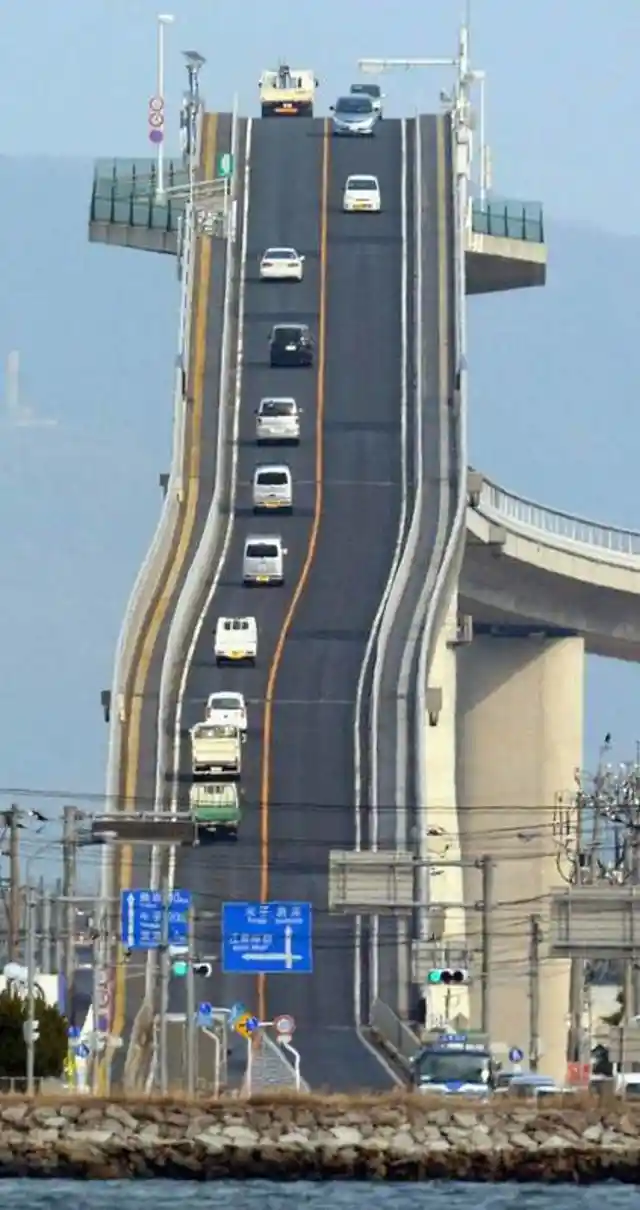
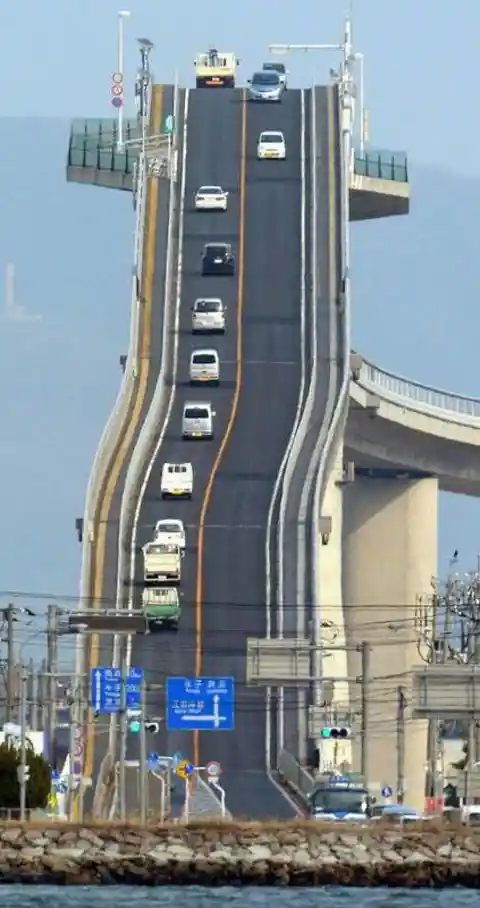
This isn't photoshop. What you're looking at is the Eshima Ohashi Bridge in Japan. The rigid-frame bridge connects two cities, Matsue, Shimane Prefecture and Sakaiminato, Tottori Prefecture over the Nakaumi lake. The Shimane side has a gradient of 6.1%, while the Tottori side has a gradient of 5.1%. The bridge is 1.7 km in length and 44.7 km in height.
Mekong River Crossings - Southeast Asia
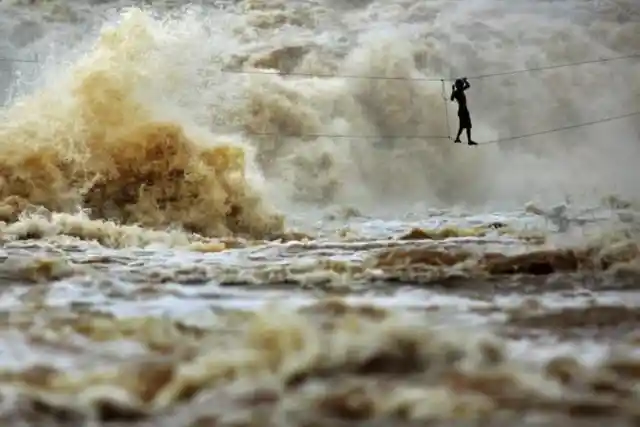
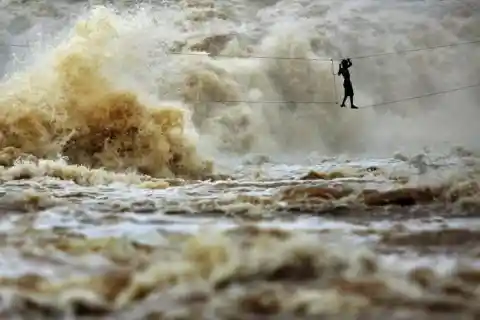
The Mekong River is the world's 12th-longest and 7th -longest in Asia. It flows from the Tibetan Plateau through China's Yunnan province, Myanmar (Burma), Laos, Thailand, Cambodia, and Vietnam. Several bridges have been constructed over the body of the river, some more minimal than others.
Millau Viaduct – France
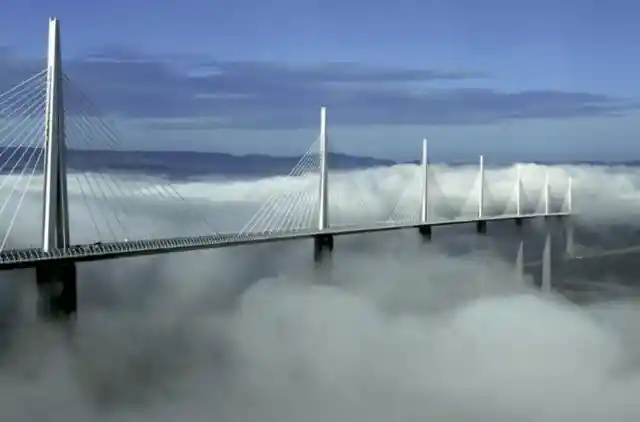
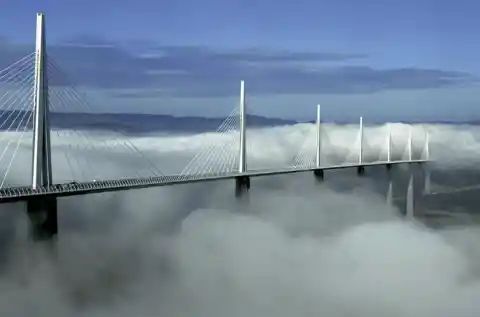
The world's tallest bridge, the Millau Viaduct (le Viaduc de Millau)is a cable-stayed bridge which spans the gorge valley of the Tarn river near Millau in southern France. It has a structural height of 1,125 feet (343 meters). The roadway measures 8,070 feet (2,460 meters) in length and 105 feet (32 meters) in width. The bridge was featured in a scene in the film Mr. Bean's Holiday.
Indo Board Bridge – Indonesia


Indo board bridges are located all over Indonesia and hang over many rivers in the country. The bridges are built with cables and wooden planking for footing. Although many families including children use the bridges daily, it remains dangerous due to the mighty rivers below.
The picture above shows school children crossing the 533-foot long ruined bridge which connected Ciwaru village to Sagagi village. Apparently, the children felt they had to use the bridge, destroyed by a flood, to get to school on time instead of walking 5 kms both ways. However, after the local residents demanded the government do something, a newer steel bridge was built.
Trift Bridge – Switzerland
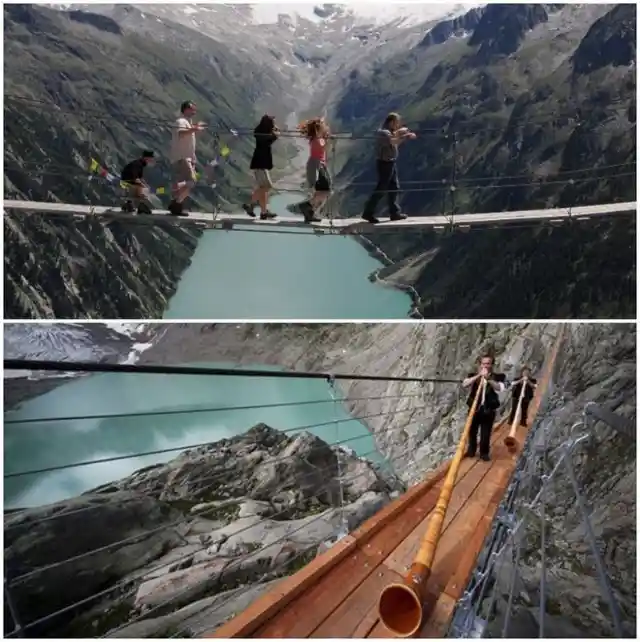
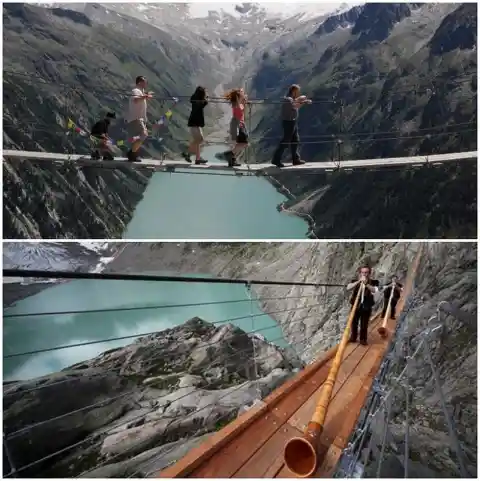
Coming in at a height 330 feet (100 meters) and spanning 560 feet (170 meters) in length, the Trift Bridge is a picturesque pedestrian-only suspension bridge located in the Swiss Alps. The Trift Bridge spans the lake, Triftsee, near Gadmen, in Switzerland and just getting to the bridge is an adventure in itself as it requires a cable car, a gondola and a 1.5-2 hour uphill hike.
Hanging Bridge Of Ghasa – Nepal
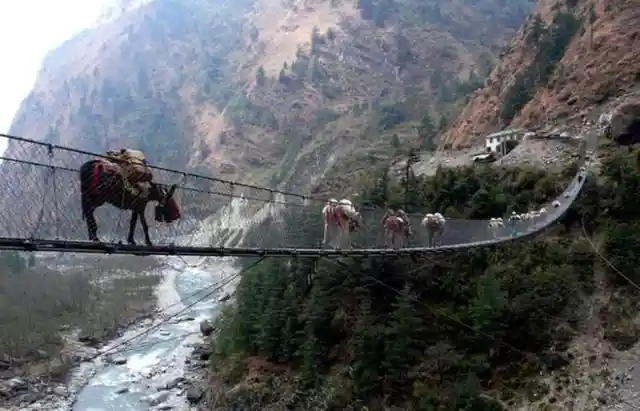
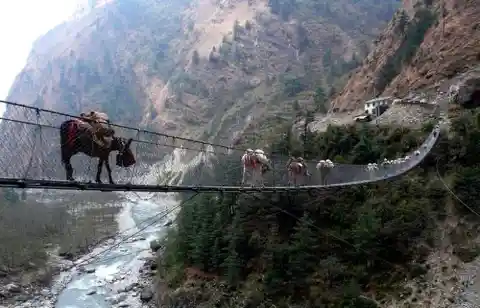
The Hanging Bridge of Ghasa in Nepal is a very long suspension bridge which was originally built to reduce congestion in the town due to herds of animals constantly walking up and down the narrow roads. Not only can travelers experience the bridge themselves, but they can also do so with a group of animals accompanying them. It is used daily by herders and farmers alike.
U Bein Bridge – Burma
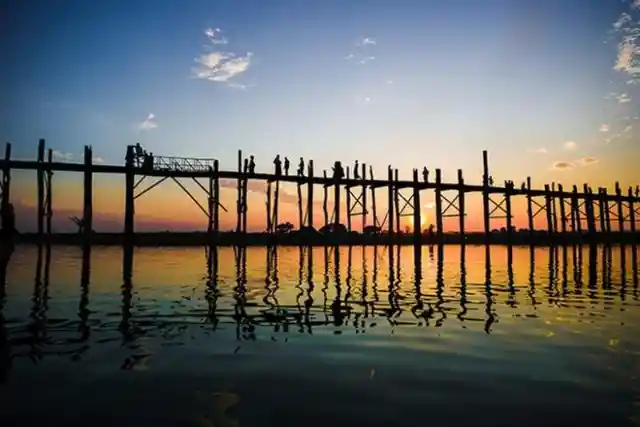
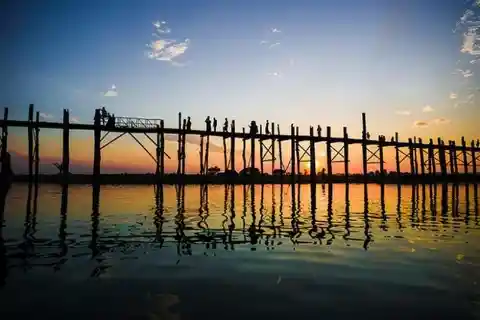
The 1,209 meter (0.75 miles) U Bein Bridge (ဦးပိန် တံတား) near Amarapura in Myanmar, spans the Taungthaman Lake and was built around 1850. It is believed to be the oldest and at one time the longest teakwood bridge in the world. According to history, engineers made scale by counting footsteps when building the bridge. In recent years, fears have grown regarding the bridge's survival.
Living Root Bridges – India
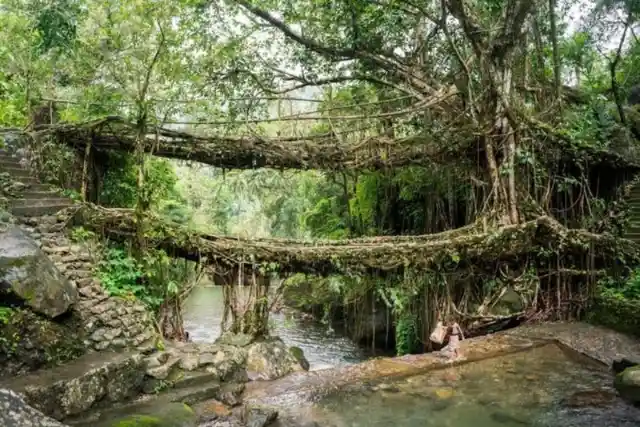
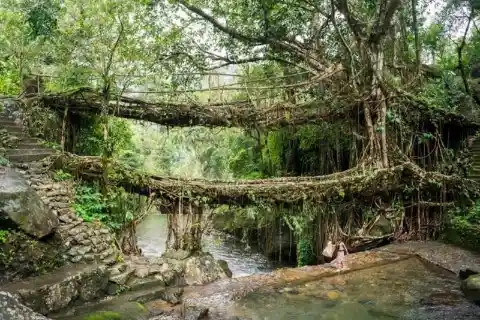
Living root bridges are a form of tree shaping which is common in parts of the Northeast Indian state of Meghalaya. The bridges are handmade from the aerial roots of rubber fig trees by the local Khasi and Kaitia peoples of the surrounding Shillong Plateau. Root bridges can also be seen in the Indian state of Nagaland.
The living root is formed by guiding the pliable roots of the tree across a stream or river, thus allowing them to grow and strengthen over time until they can hold the weight of a human being. At times, the young roots are tied or twisted together. Another method is to combine the two in a process of inosculation.
Plank Road In The Sky – China
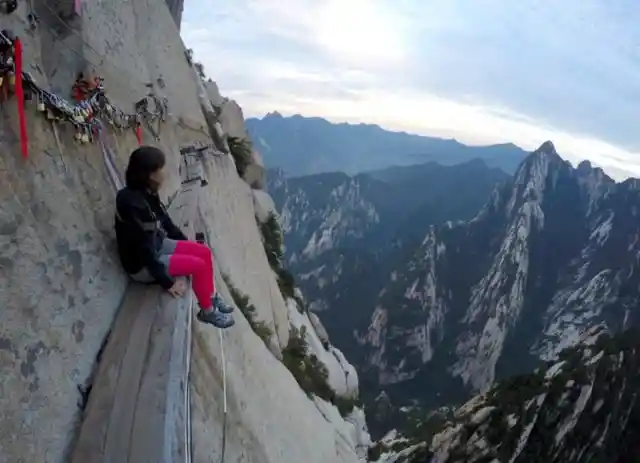

While it might be a stretch to call this a "bridge", it is certainly worth "crossing" for those brave enough. One of China's five sacred mountains, Mount Hua (or Huashan) is located near the city of Xi’an in the Shaanxi province and is famous for its infamous "plank in the sky" rail.
At over 7,000 feet (2,134 meters) high, the only way to cross the planks is by connecting a harness to the rope which swings around the mountain. Due to the narrowness of the path, traffic goes both ways, with one of the travelers being required to unclip and reclip their harness after passing the other person. Thanks, but no thanks.
Geumgang Gureum (Cloud) Bridge – South Korea
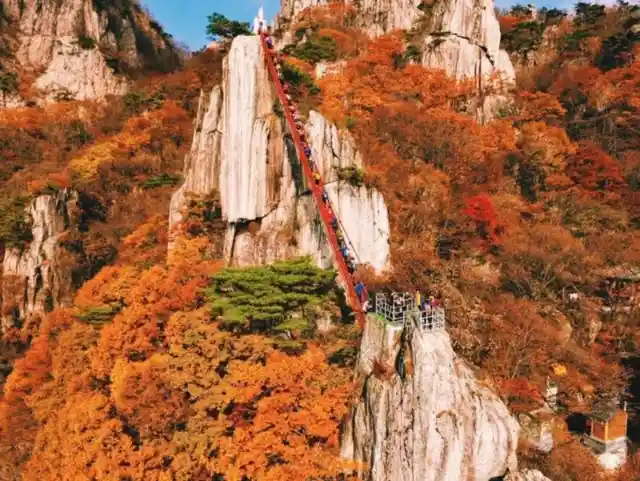

Located in the Chungcheongnam-do of western South Korea, Mount Daedun (Daedunsan) has an elevation of 878 meters. It is lies between the cities of Daejon and Jeonju. The Geumgang Gureum (Cloud) Bridge takes up 50 meters of the trail up to Daedunsan. The 127-step ladder bridge stands at an angle of 70 degrees and appears as if one is walking all the way up to the clouds.
The Rolling Bridge, England
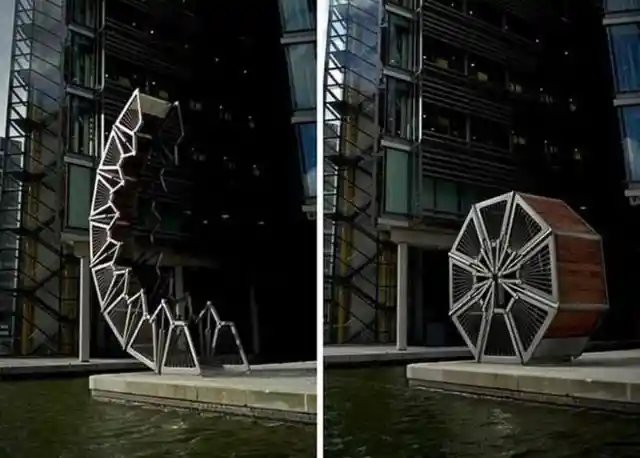
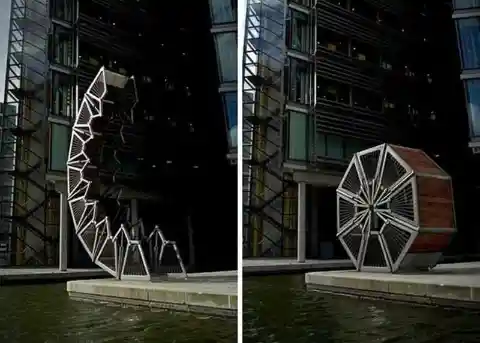
Designed as part of the Grand Union Canal office and retail development project at Paddington Basin, London, The Rolling Bridge is a type of curling movable bridge which was completed in 2004. To allow passage of boats, the hydraulic pistons are activated with the bridge then curling up until its ends join, forming an octagon. The bridge measures 12 meters long when extended.
Nanjing Yangtze River Bridge, China
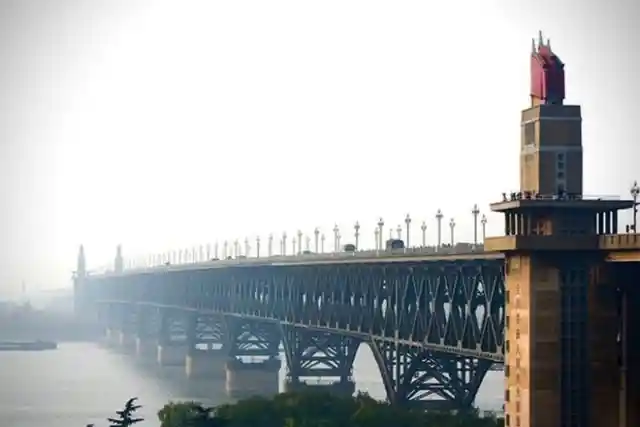
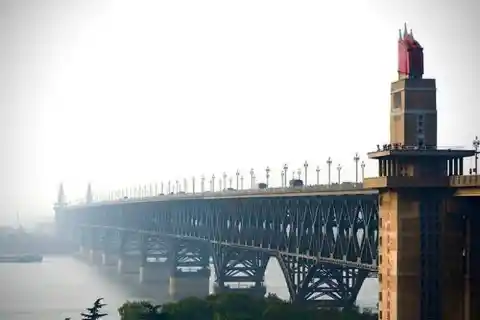
According to Chinese state media, the Nanjing Yangtze River Bridge is the most frequent suicide site in the world, more than 2,000 suicides estimated by 2006. The bridge is a double-decked road-rail bridge across the Yangtze River between Pukou and Xiaguan in Nanjing, China and measures 230 feet (70 meters) high.
Si-O-Se-Pol Bridge, Iran
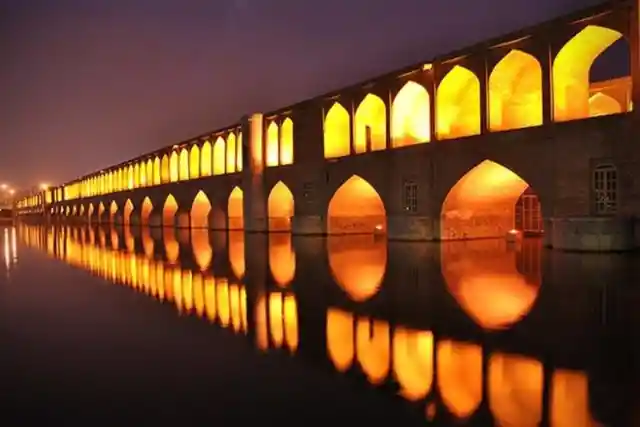
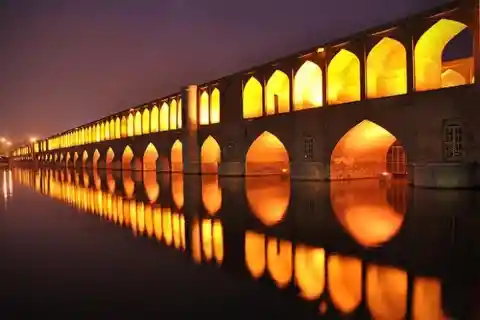
The Allahverdi Khan Bridge, more popularly known as Si-o-se-pol (سیوسهپل) which means " bridge of thirty-three ", was built in the early 17th century between 1599 and 1602 to serve as both a bridge and a dam. The bridge has a is 976.9 feet (297.76 meters) long, with a total width of 48.4 feet (14.75 meters) and is made of stone.
The interior of the bridge had originally been decorated with paintings, which travelers used to describe as being erotic. The bridge is the largest of the eleven historical bridges on the Zayanderud, the largest river of the Iranian Plateau, in Isfahan, Iran.
Bridge Of Sighs, Italy
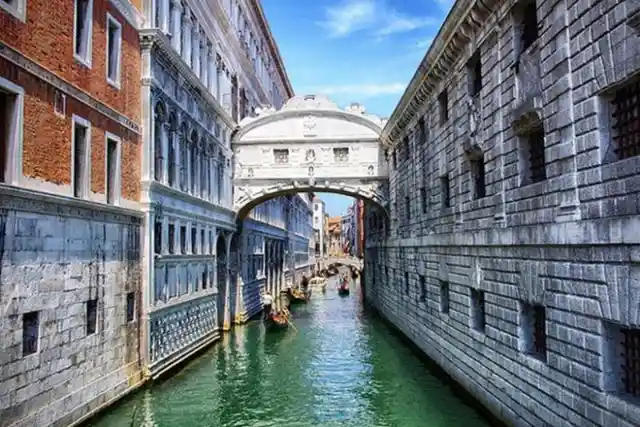
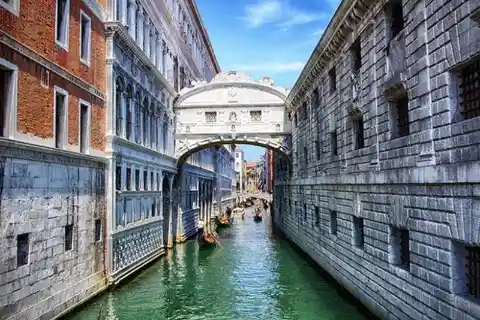
Venice's Bridge of Sighs (Ponte dei Sospiri) in Italy was built in 1600 and was the last view of Venice convicts saw before their imprisonment. The name allegedly comes from Lord Byron who suggested, prisoners would sigh at their final view of the beautiful city through the window before being taken to their underground cells.
The bridge is made of white limestone and passes over the Rio di Palazzo, connecting the New Prison to the interrogation rooms in the Doge's Palace.
Rialto Bridge, Italy
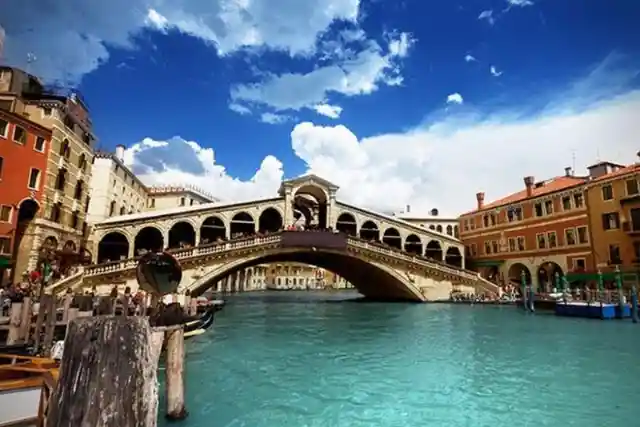
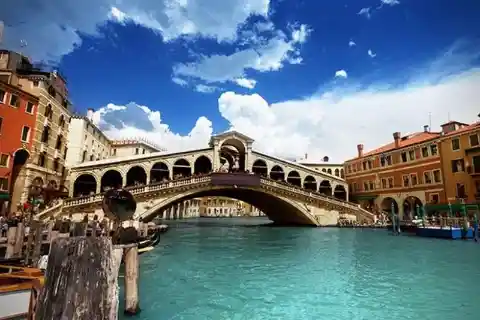
The Rialto Bridge (Ponte di Rialto) is the oldest of the four bridges spanning Venice's Grand Canal. It connects the districts of San Marco and San Polo and has been rebuilt several times since its first construction as a pontoon/floating bridge in the 12th century. The current stone bridge, a single span designed by Antonio da Ponte, was finally completed in 1591.
Chengyang Wind And Rain Bridge, China
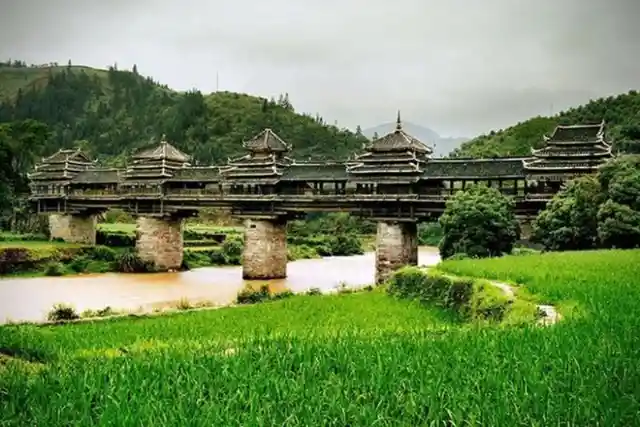
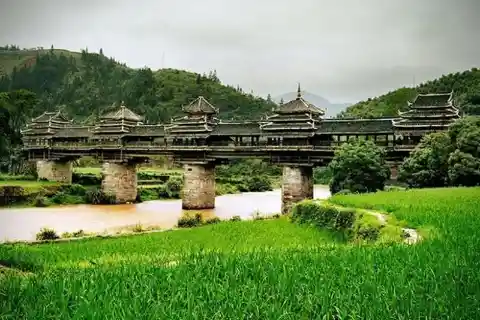
The Yongji Bridge of Chengyang also called the Chengyang Wind and Rain Bridge (程陽風雨橋, Chéngyáng Fēngyǔ Qiáo) is a bridge in Sanjiang Country, of Guangxi, China. It is a special covered bridge and was completed in 1912. It is a combination of bridge, corridor, veranda, and Chinese pavilion. No nails or rivets were used, instead, builders dovetailed thousands of pieces of wood.
Chapel Bridge, Switzerland
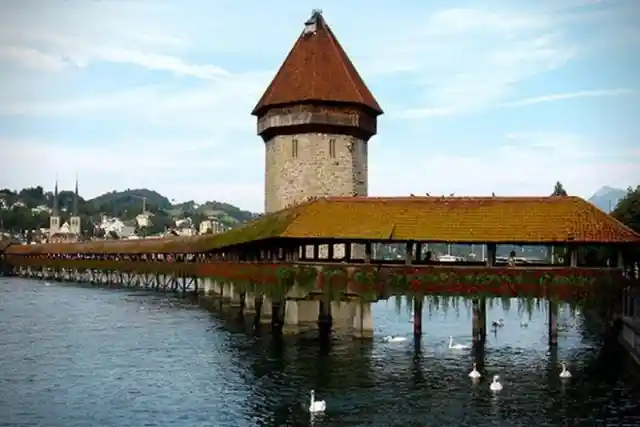
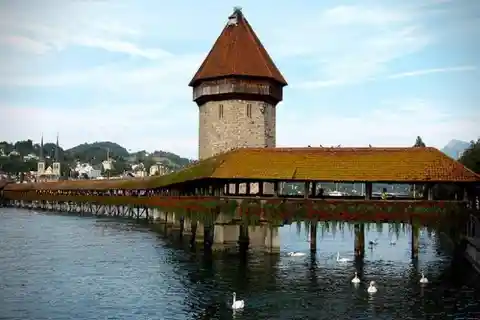
Built in 1333, the Kapellbrücke (literally, "Chapel Bridge") is a covered wooden footbridge spanning across the Reuss river the city of Lucerne, Switzerland. The bridge contains a number of interior paintings dating back to the 17th century and is the oldest wooden covered bridge in all of Europe as well as the world's oldest surviving truss bridge.
Aiguille du Midi Bridge, French Alps
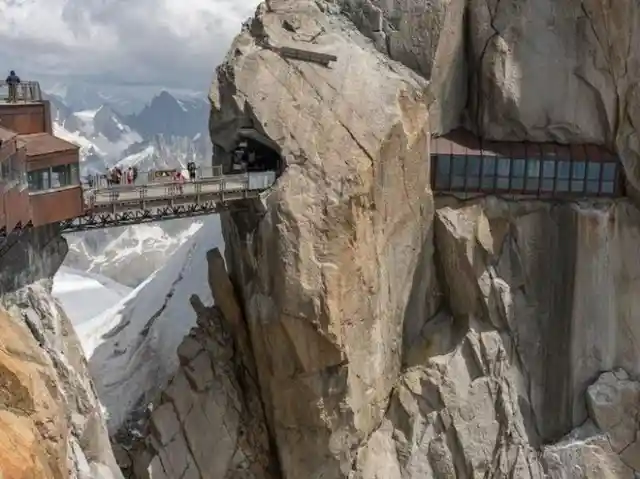
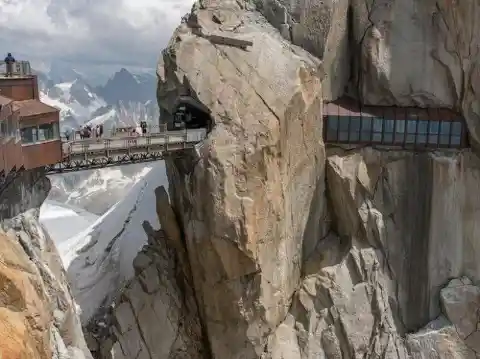
The Aiguille du Midi mountain bridge overpass sits at 12,605 feet (3,842 meters) in the Mont Blanc massif in the French Alps. The cable car from the ski resort of Chamonix to the top of the Aiguille du Midi, an altitude gain of over 2,800 meters, takes 20 minutes.
The name "Aiguille du Midi" translates as "Needle of the Mid-day" perhaps because the sun appears over its summit around noon when seen from one of the town's churches.
Zhangjiajie Grand Canyon Glass Bridge, China
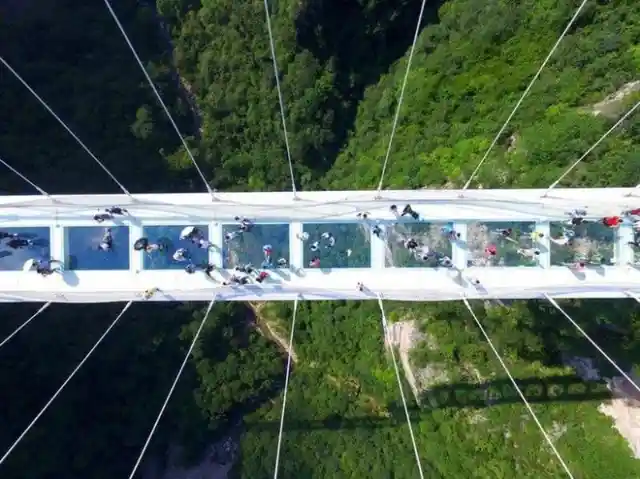
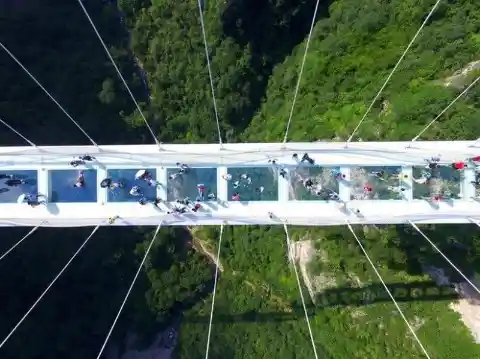
When it was first opened in August 2016, the Zhangjiajie Glass Bridge was the was the longest and tallest glass-bottomed bridge in the world. Measuring 1,410 feet (430 meters) spanning the canyon between two mountain cliffs in Zhangjiajie National Forest Park in China's central Hunan province, there is also provision for making a 935 foot (285 meter) bungy-jump.
Caravan Bridge, Turkey
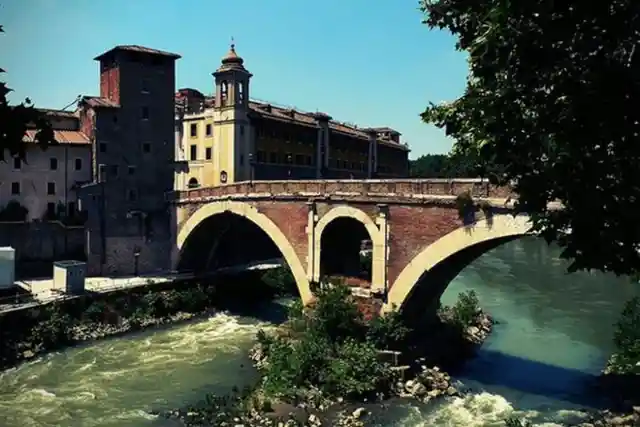
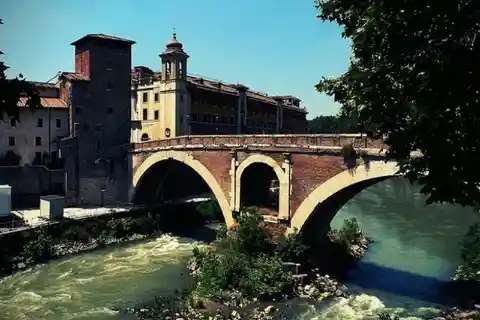
The Caravan Bridge (Kemer Köprüsü) in the city of İzmir, Turkey, is an ancient bridge which was built approximately 850 BCE over the Meles river. It is one of the oldest man-made structures in continuous use, and as such is believed to be the oldest functioning bridge in the world. Historical figures such as Homer, and Paul the Apostle have crossed this bridge according to reports.
Pont Gustave Flaubert, France
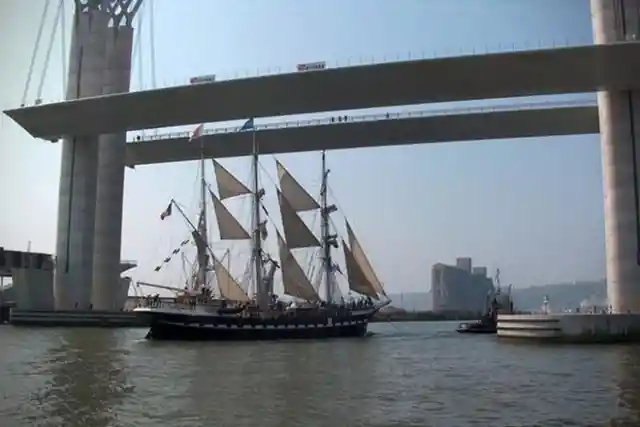
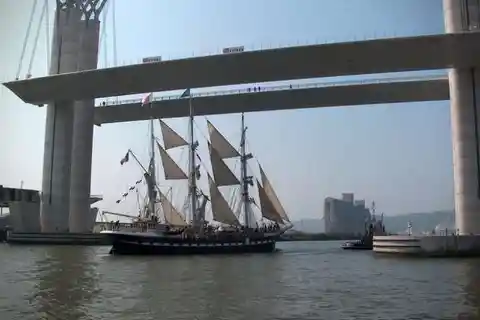
The Pont Gustave Flaubert is a vertical-lift bridge over the River Seine in Rouen, Seine-Maritime, Normandy, France. It has a bridge span of 390 feet (120 meters) with a total height of 282 feet (86 meters). It is the tallest lift bridge in the world and takes twelve minutes to fully raise or lower the lift section.
Hangzhou Bay Bridge, China
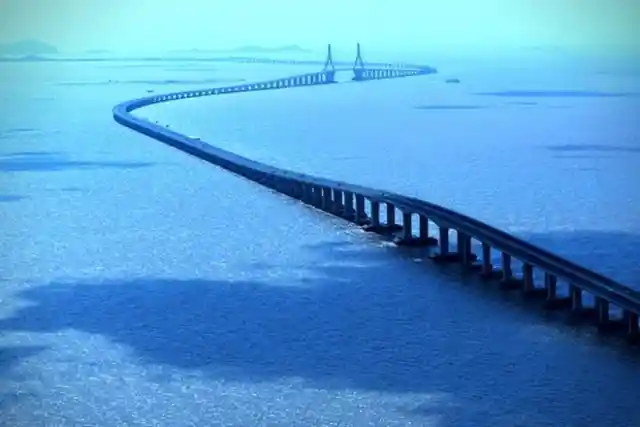
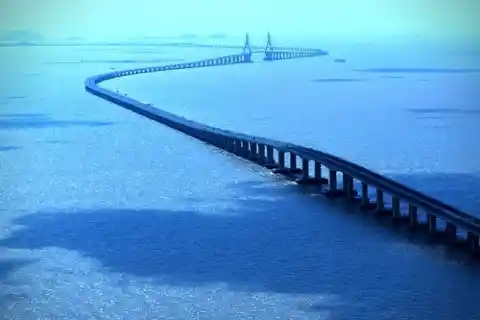
The Hangzhou Bay Bridge (杭州灣大橋, Hángzhōu Wān Dàqiáo) is a highway bridge which crosses the Hangzhou Bay in the eastern coastal region of China. The bridge shortened the highway travel between the cities of Ningbo and Shanghai from 400 km (249 miles) to 180 km (112 miles), thereby reducing travel time from 4 to 2 hours.
Furthermore, a 110,000 square foot (10,000 square meter) service center called "Land between the Sea and the Sky" was built in the middle of the bridge and consists of shopping/exhibition/parking/restaurant facilities, a hotel and a 146-meter high lookout tower which serves as a tourist attraction.
New Brunswick Hartland Bridge, Canada
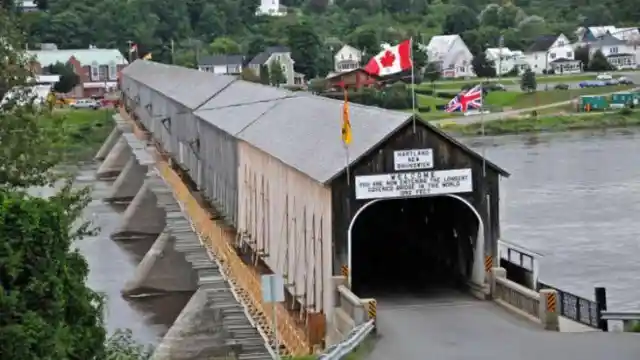
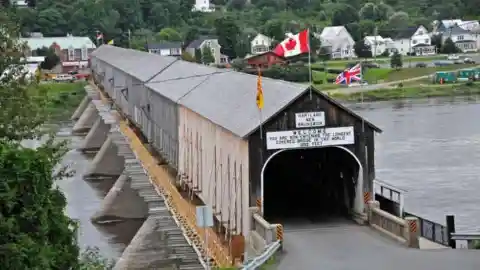
Located in Hartland, New Brunswick, Canda, the Hartland Bridge is the world's longest covered bridge. It measures 1,282 feet (391 meters) long and crosses the Saint John River from Hartland to Somerville, New Brunswick, Canada. According to local legend, it is believed to be good lick to hold one's breath the entire way across the bridge while driving.
Ponte Vecchio, Italy
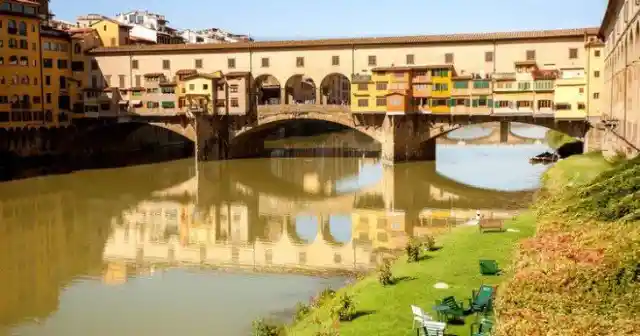

The Ponte Vecchio means "Old Bridge" in Italian and spans the Arno river at its narrowest point. It is believed that the bridge was first built in Roman times and first appears in a document in the year 996. The bridge consists of three segmental arches is renown for always having hosted shops and merchants who displayed their goods on tables before their premises.
It is believed the economic concept of bankruptcy originated here when a money-changer could not pay his debts, the table on which he sold his wares (the "banco") was physically broken ("rotto") by soldiers, and this practice was called "bancorotto" (broken table). Not having a table anymore, the merchant was not able to sell anything.
Magdeburg Water Bridge, Germany
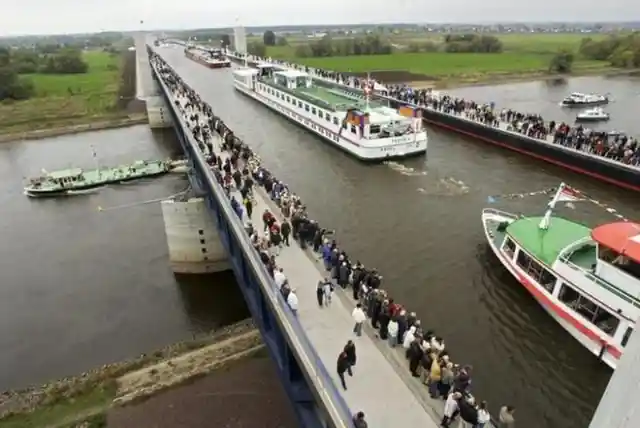

The Magdeburg Water Bridge connects Berlin’s inland harbor network with the ports along the Rhine River. It is the largest canal underbridge in Europe and spans the river Elbe which allows commercial ships to pass the Rhineland and Berlin without needing to descend and ascending out of the Elbe itself. The bridge measures 3,012 feet (918 meters) in length.
Helix Bridge, Singapore
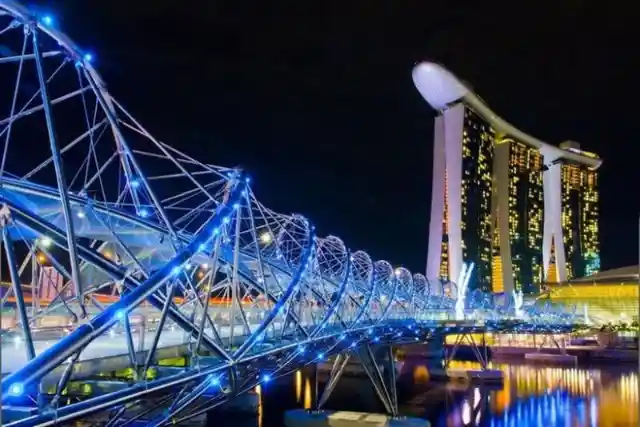
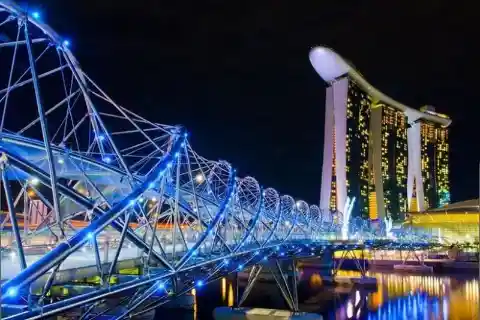
Singapore's Helix Bridge, officially called The Helix, is a pedestrian bridge linking Marina Centre with Marina South in the Marina Bay area of the country. Pairs of colored letters "c" and "g", as well as "a" and "t" on the bridge are lit up at night in red and green to represent cytosine, guanine, adenine and thymine, the four bases of DNA. The bridge is 919 feet (280 meters) long.
Charles Bridge, Czech Republic
